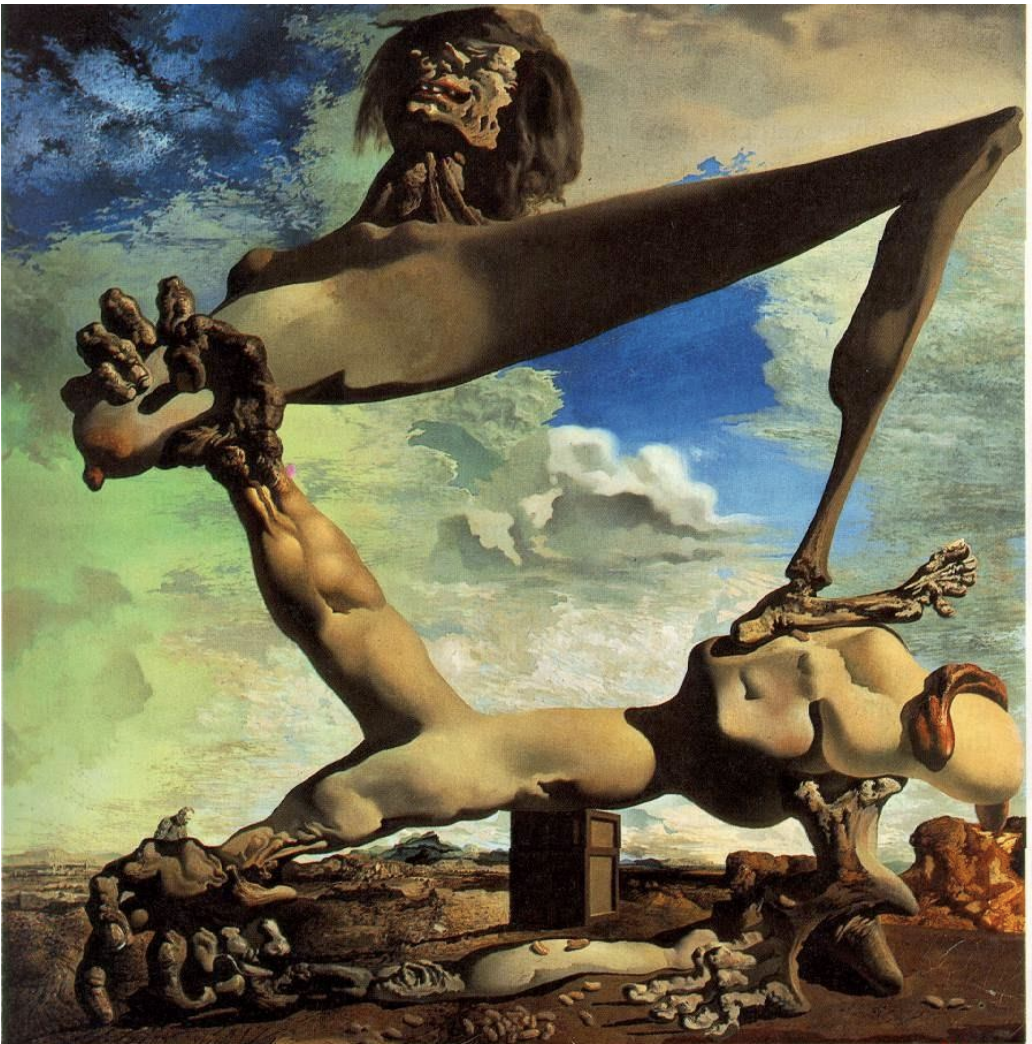Spanish Art Masters Final Exam
1/39
There's no tags or description
Looks like no tags are added yet.
Name | Mastery | Learn | Test | Matching | Spaced |
|---|
No study sessions yet.
40 Terms
El Greco: The Disrobing of Christ (1577-79)
Style: Mannerism
Key Features:
El Greco’s elongated, expressive figures.
Dramatic use of light and color to emphasize spiritual themes.
Depicts Christ being disrobed before the crucifixion, with figures surrounding Him in an emotional moment of reverence.
Memorable Fact: The swirling figures and intense use of color are hallmarks of El Greco's style.
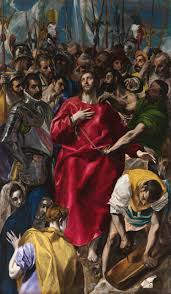
El Greco: The Burial of the Count of Orgaz (1586-88)
Style: Mannerism
Key Features:
A blend of realism and religious symbolism.
The burial scene of Count Orgaz, who was a local nobleman, depicted with angels and saints in the upper section of the canvas.
The earthly and divine are merged in the composition, with a contrast of realism in the lower part and a more ethereal, spiritual atmosphere in the top.
Memorable Fact: El Greco’s ability to combine religious themes with the portrayal of real people was groundbreaking for the time.
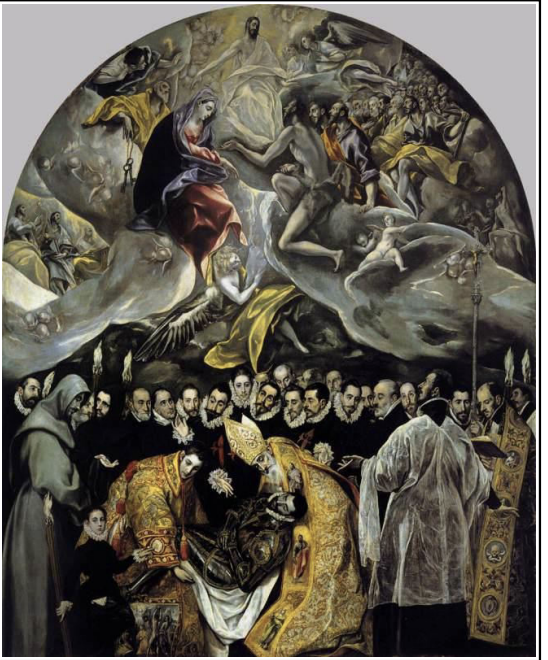
El Greco: Annunciation (1596-1600)
Key Features:
Depicts the angel Gabriel announcing to Mary that she will bear the Son of God.
El Greco’s signature elongated figures and dramatic use of color and light.
The composition creates an ethereal, otherworldly quality.
Memorable Fact: El Greco’s unusual, vibrant color palette makes this an example of his unique take on religious art.
Inspired by the work of Titian
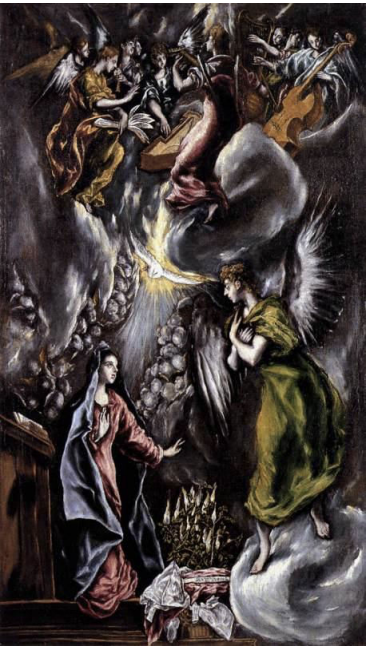
El Greco: Crucifixion (1596-1600)
The depiction of Christ on the cross is elongated and expressive.
Surreal, vibrant colors and swirling forms contribute to the emotional intensity.
The figure of Christ is central, surrounded by saints and angels.
Memorable Fact: El Greco’s religious themes often push the boundaries of form and color, creating emotional and spiritual intensity.
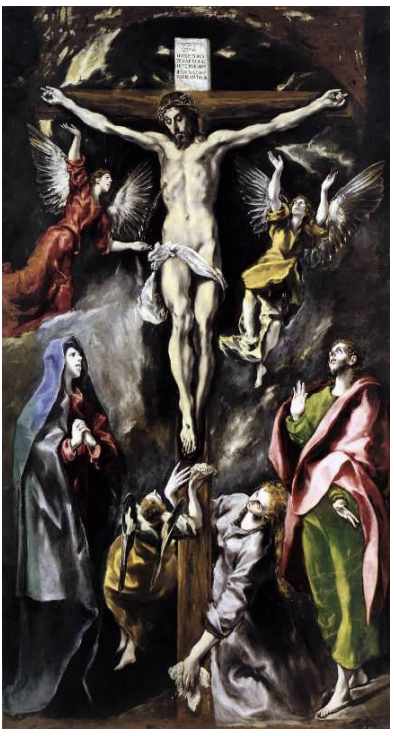
José de Ribera: St Andrew (1630-32)
Style: Baroque
Key Features:
Depicts St. Andrew in a dramatic pose, emphasizing his suffering and martyrdom.
Dark, moody color palette typical of Ribera’s "tenebrism" technique, with sharp contrasts of light and shadow.
Realistic, highly detailed portrayal of the saint’s body and expression.
Memorable Fact: Ribera is known for his intense realism and emotional depth in religious subjects.
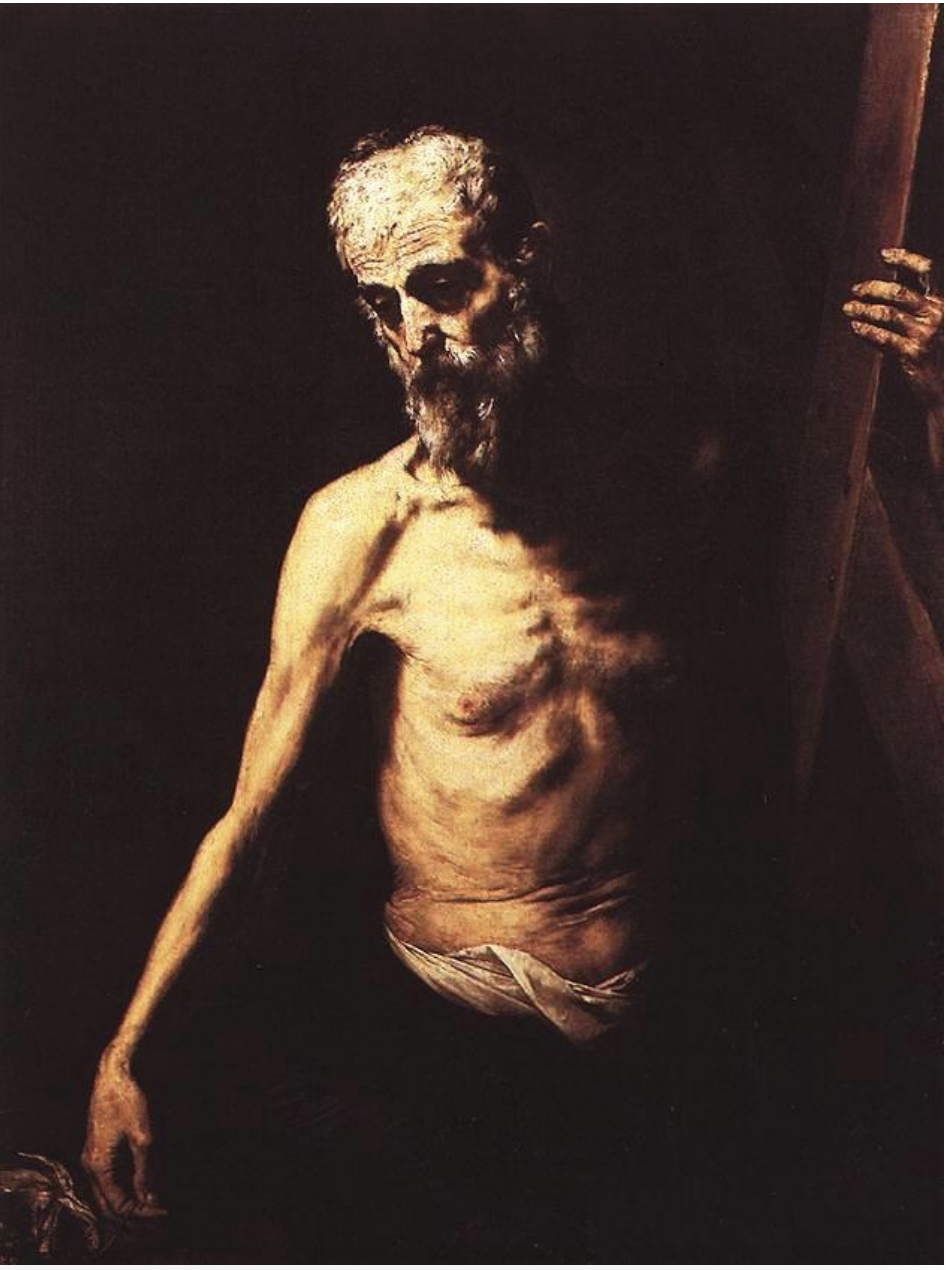
José de Ribera: Clubfooted Boy (1642)
Key Features:
A realistic portrayal of a young boy with a deformity (clubfoot).
Strong contrasts of light and shadow.
Emotional intensity and the emphasis on the human condition.
Memorable Fact: Ribera’s paintings often focus on human suffering and the body in a very realistic way.
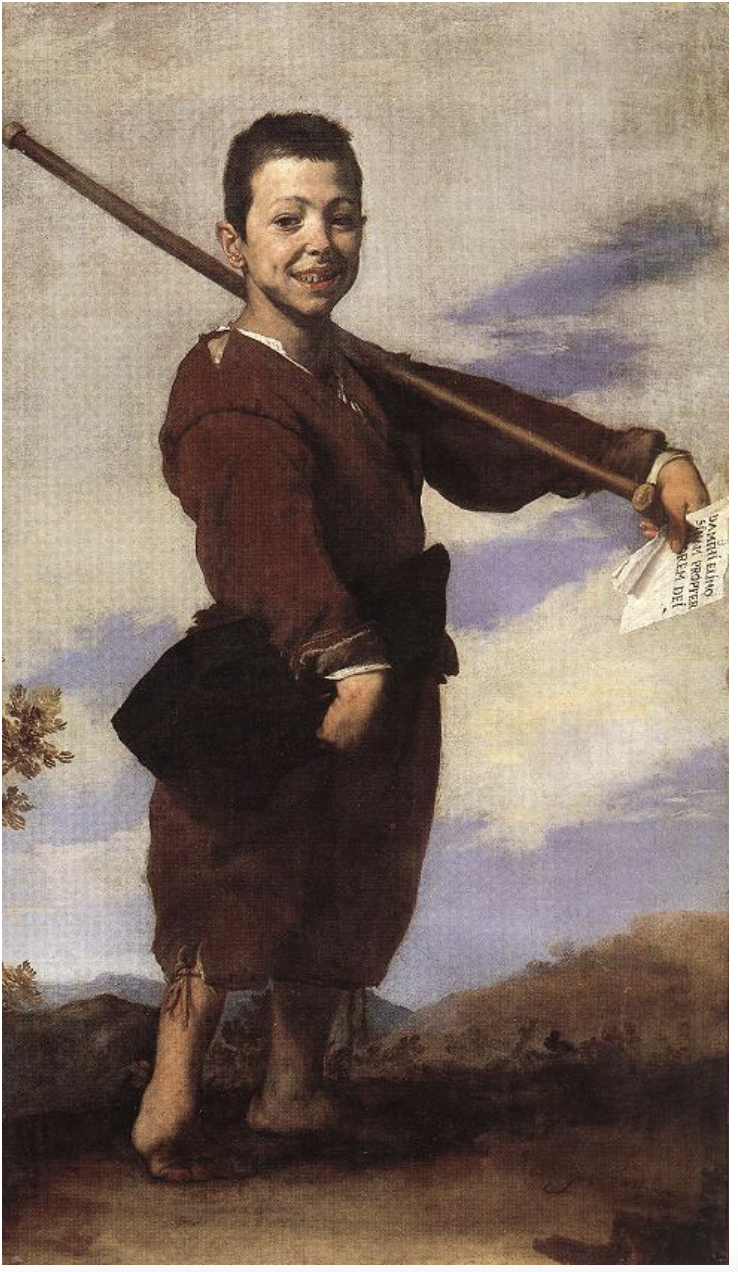
José de Ribera: Magdalena Ventura with Her Husband and Son (1631)
Key Features:
A powerful depiction of Magdalena Ventura, a woman who grew a beard due to a medical condition.
Focus on realism and emotional expression.
Use of light and shadow to enhance the dramatic effect.
Memorable Fact: Ribera’s ability to paint unusual or “unnatural” subjects in a realistic manner was groundbreaking.
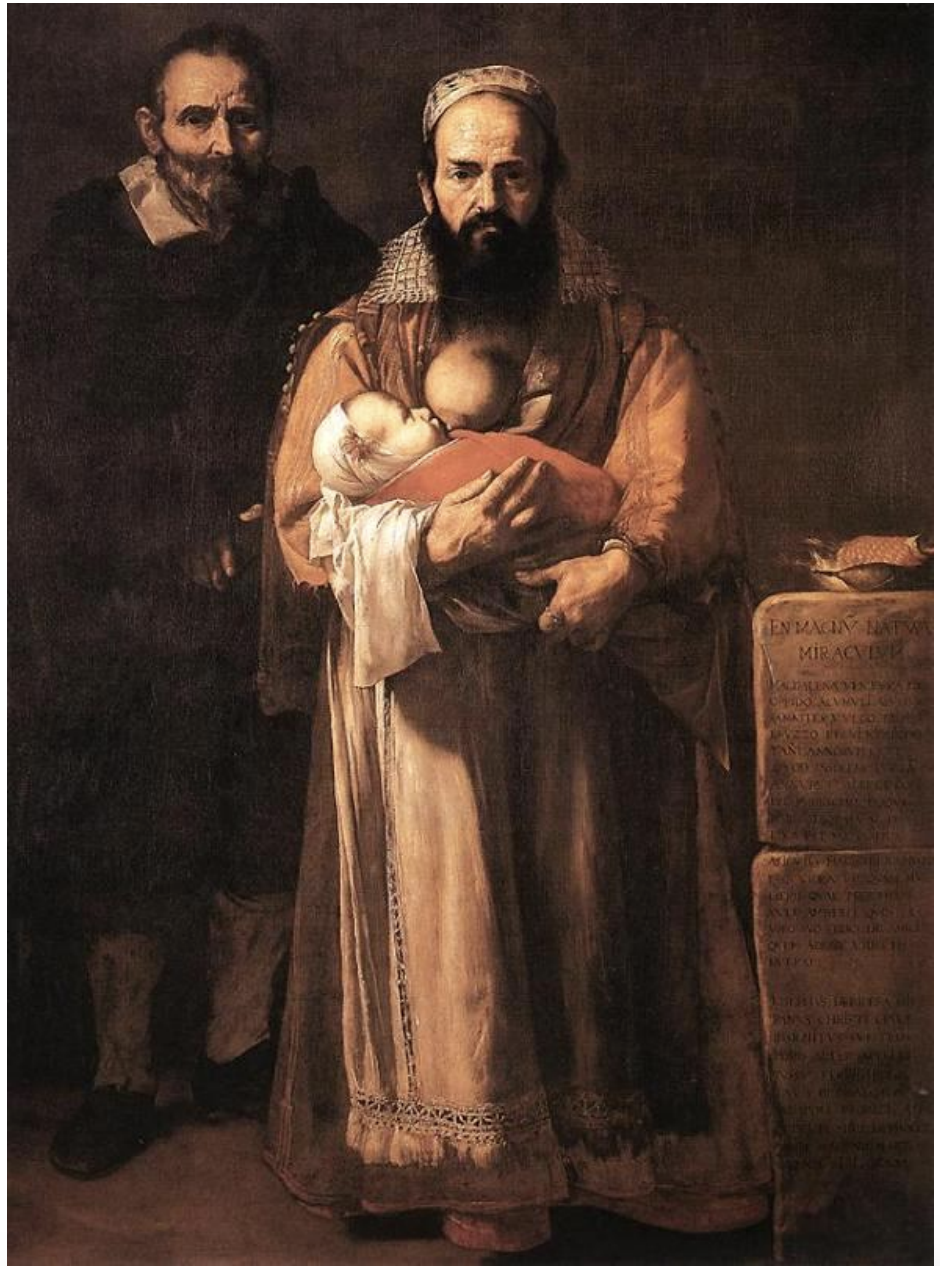
Francisco de Zurbarán: The Apostle Saint Peter appearing to Saint Peter Nolasco (1629)
Key Features:
The supernatural vision of Saint Peter appearing to Saint Peter Nolasco.
Realistic, serene, and almost mystical portrayal of the figures.
Deep contrasts of light and dark typical of Baroque art.
Memorable Fact: Zurbarán’s works are often meditative and calm, with a focus on spiritual depth.

Bartolomé Esteban Murillo: Boys Eating Grapes and Melon (1645-46)
Key Features:
Depicts two young boys eating fruit, an example of Murillo's skill in portraying everyday life.
Soft, gentle use of light and color.
The painting gives a sense of innocence and joy.
Memorable Fact: Murillo is known for his depictions of children and domestic scenes with a tender, light touch.

Bartolomé Esteban Murillo: Infant Christ Offering a Drink of Water to St John (1675-1680)
Key Features:
A tender depiction of the infant Christ offering water to Saint John the Baptist.
Soft, glowing light and a gentle color palette.
The emotion of innocence and holiness is emphasized through the serene expressions.
Memorable Fact: Murillo often painted religious themes with a focus on the warmth and tenderness of the figures.
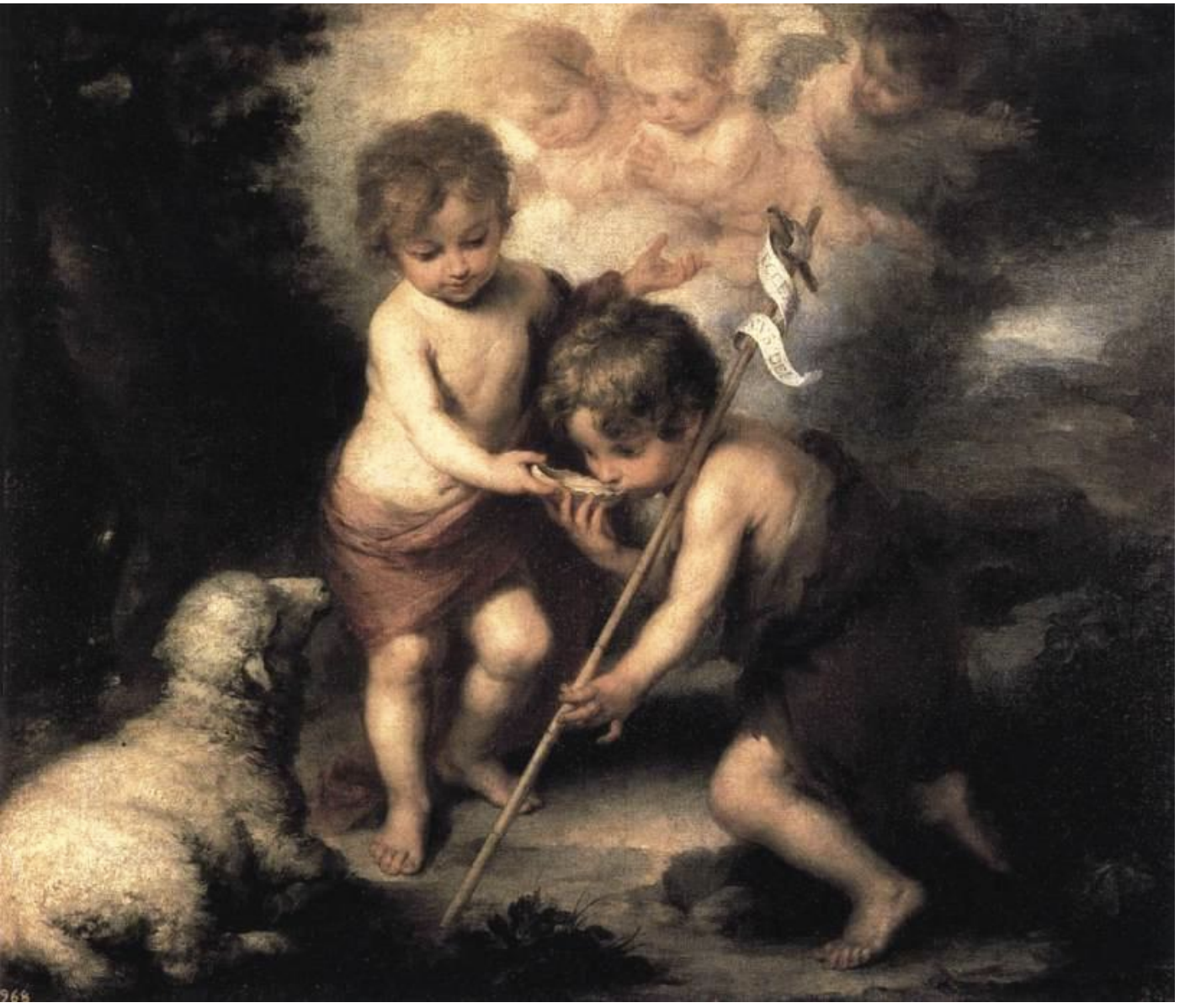
Bartolomé Esteban Murillo: Immaculate Conception (c. 1667-70)
Key Features:
Depicts the Virgin Mary in a heavenly scene, symbolizing purity and divine grace.
Murillo’s soft, glowing light gives the painting a heavenly, idealized quality.
Memorable Fact: This is one of Murillo's most famous works, exemplifying his skill in portraying sacred subjects with tenderness and beauty.
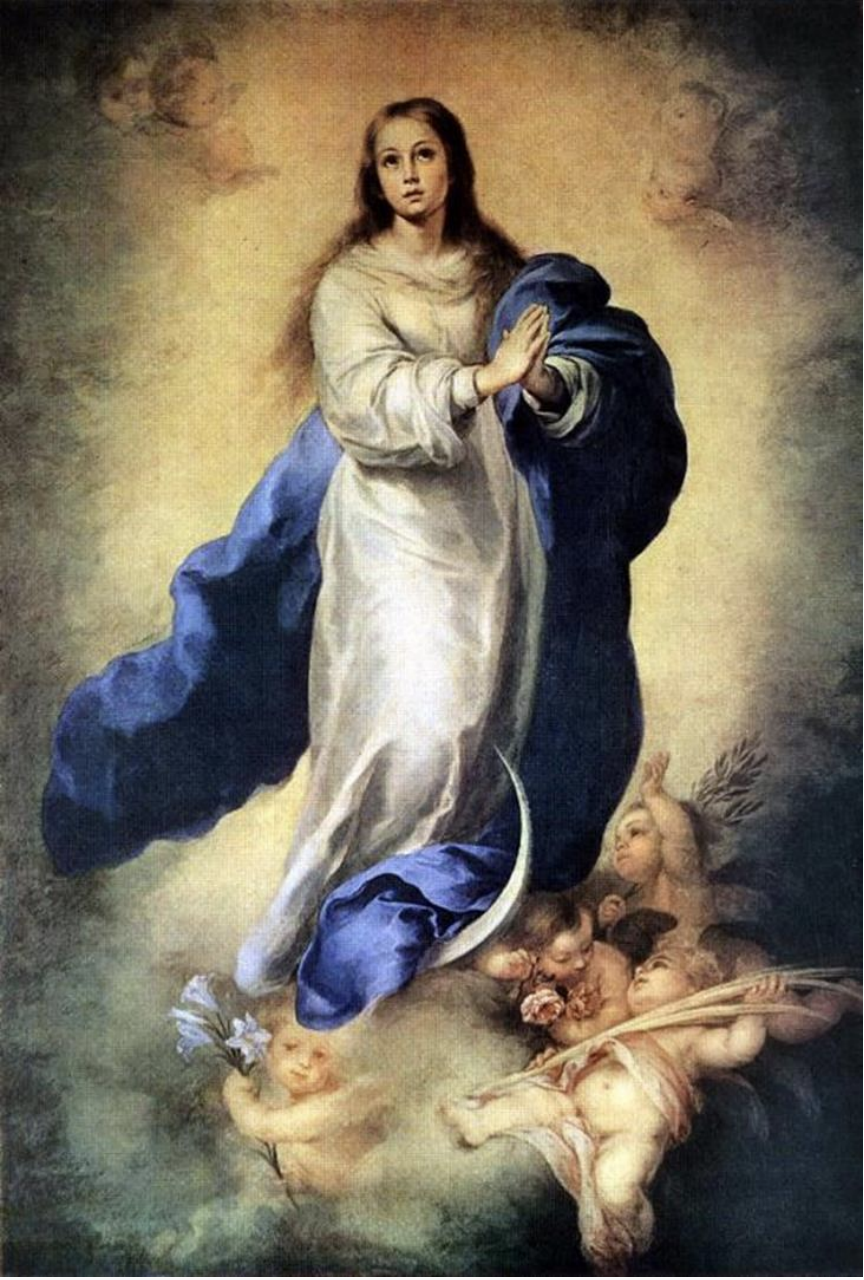
Diego Velázquez: Old Woman Frying Eggs (1618)
Style: Baroque, Realism
Key Features:
A still-life subject: an old woman frying eggs, depicted with remarkable realism.
Velázquez’s skill in capturing everyday life with incredible detail and light.
Memorable Fact: Velázquez’s approach to everyday subjects elevated the mundane to high art.
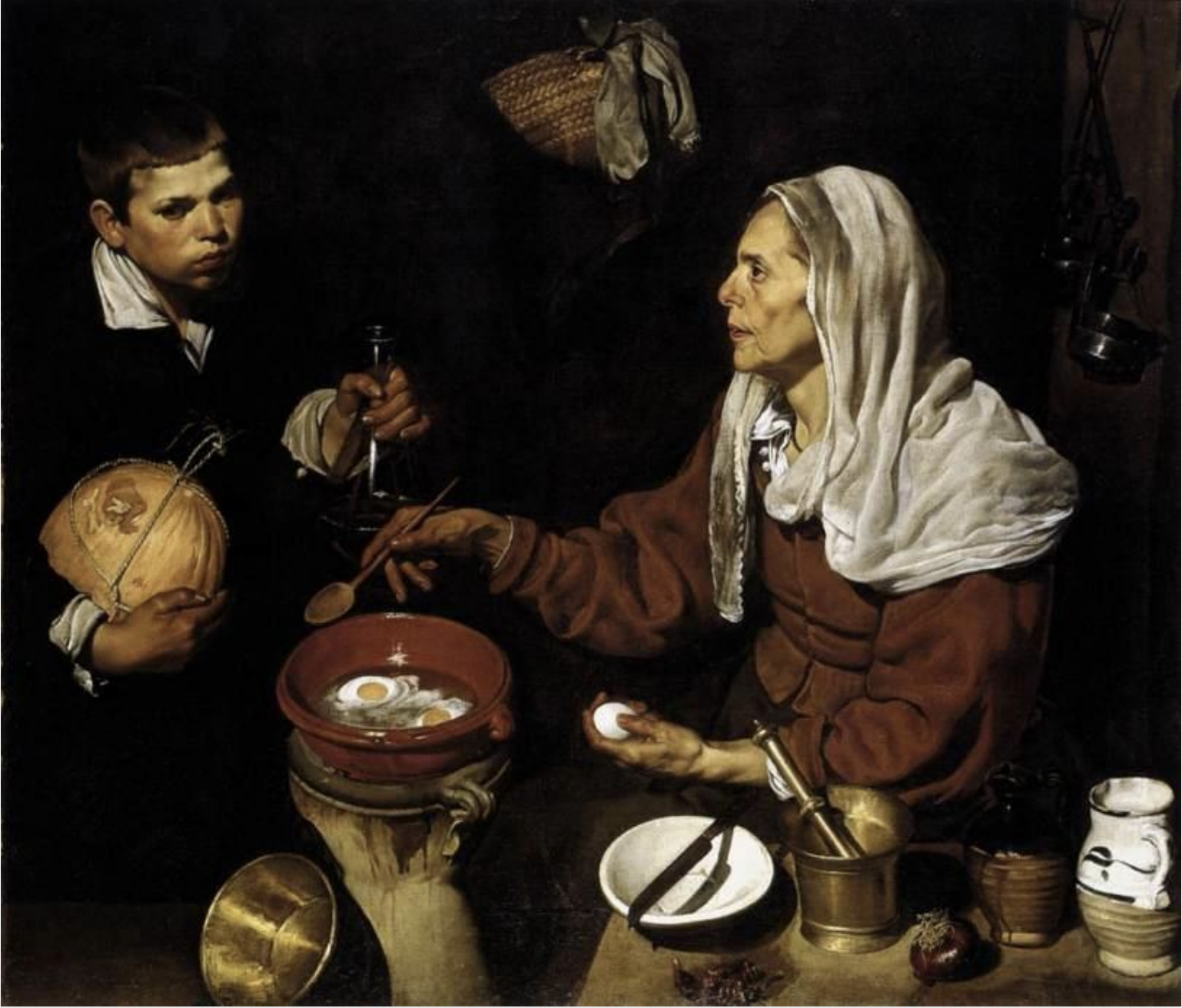
Diego Velázquez: The Triumph of Bacchus (Los Borrachos) (c. 1623)
Style: Baroque, Realism
Key Features:
Depicts the god Bacchus and his followers, celebrating in a wild, drunken revel.
The focus on light and shadow gives the figures a sense of realism and immediacy.
Memorable Fact: Velázquez’s ability to blend mythology with realism is evident in this painting.
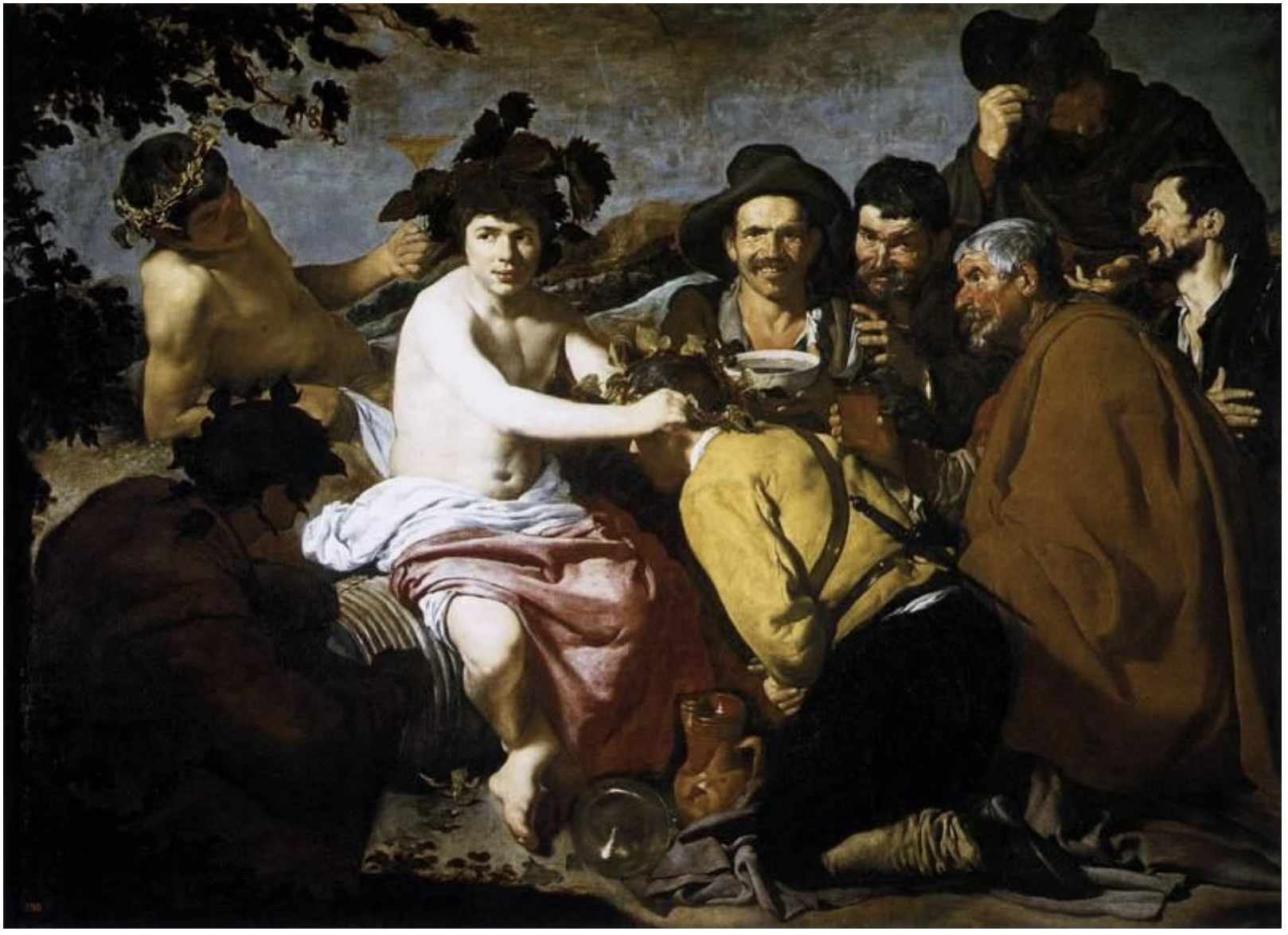
Diego Velázquez: The Count-Duke of Olivares on Horseback (1634)
Key Features:
A portrait of the Count-Duke of Olivares, a powerful political figure in the Spanish court.
Velázquez’s use of light and detailed rendering of the horse and figure.
Memorable Fact: This portrait captures the dignity and power of Olivares through masterful brushwork.

Diego Velázquez: The Surrender of Breda (Las lanzas) (1634-35)
Key Features:
Depicts the surrender of the Dutch city of Breda to the Spanish forces.
Velázquez portrays the scene with a sense of dignity and respect for both sides, avoiding glorifying one over the other.
Memorable Fact: The painting is famous for its detailed depiction of the military scene, showcasing Velázquez’s mastery in both history and portraiture.
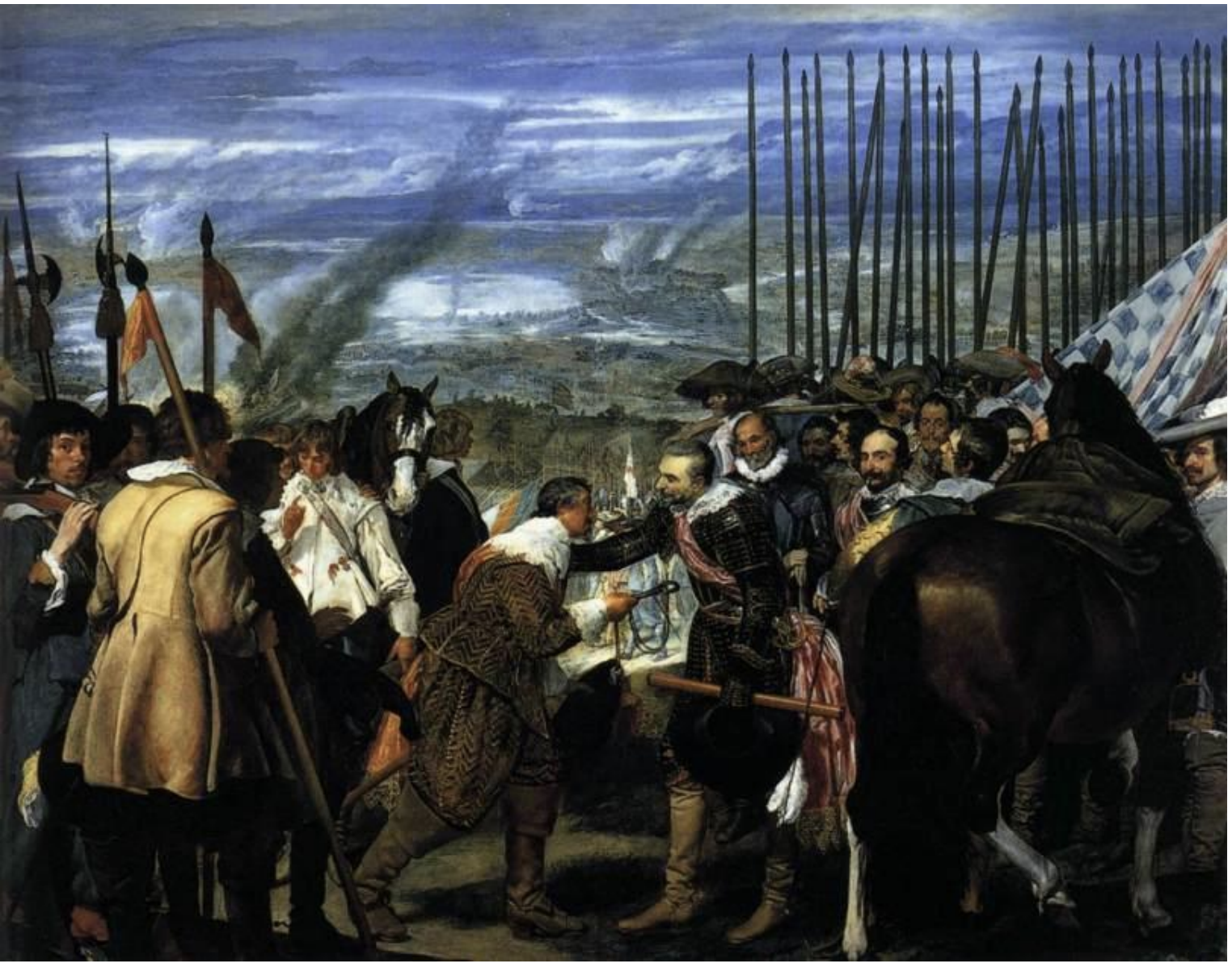
Diego Velázquez: The Dwarf Francisco Lezcano, Called "El Niño de Vallecas" (1643-45)
Key Features:
Portrait of Francisco Lezcano, a court dwarf, with a dignified and respectful portrayal.
Velázquez’s realism and sensitivity to his subjects stand out in this portrayal of a person often marginalized in society.
Memorable Fact: This work is significant for its respectful portrayal of a dwarf, showing Velázquez’s deep empathy for his subjects.
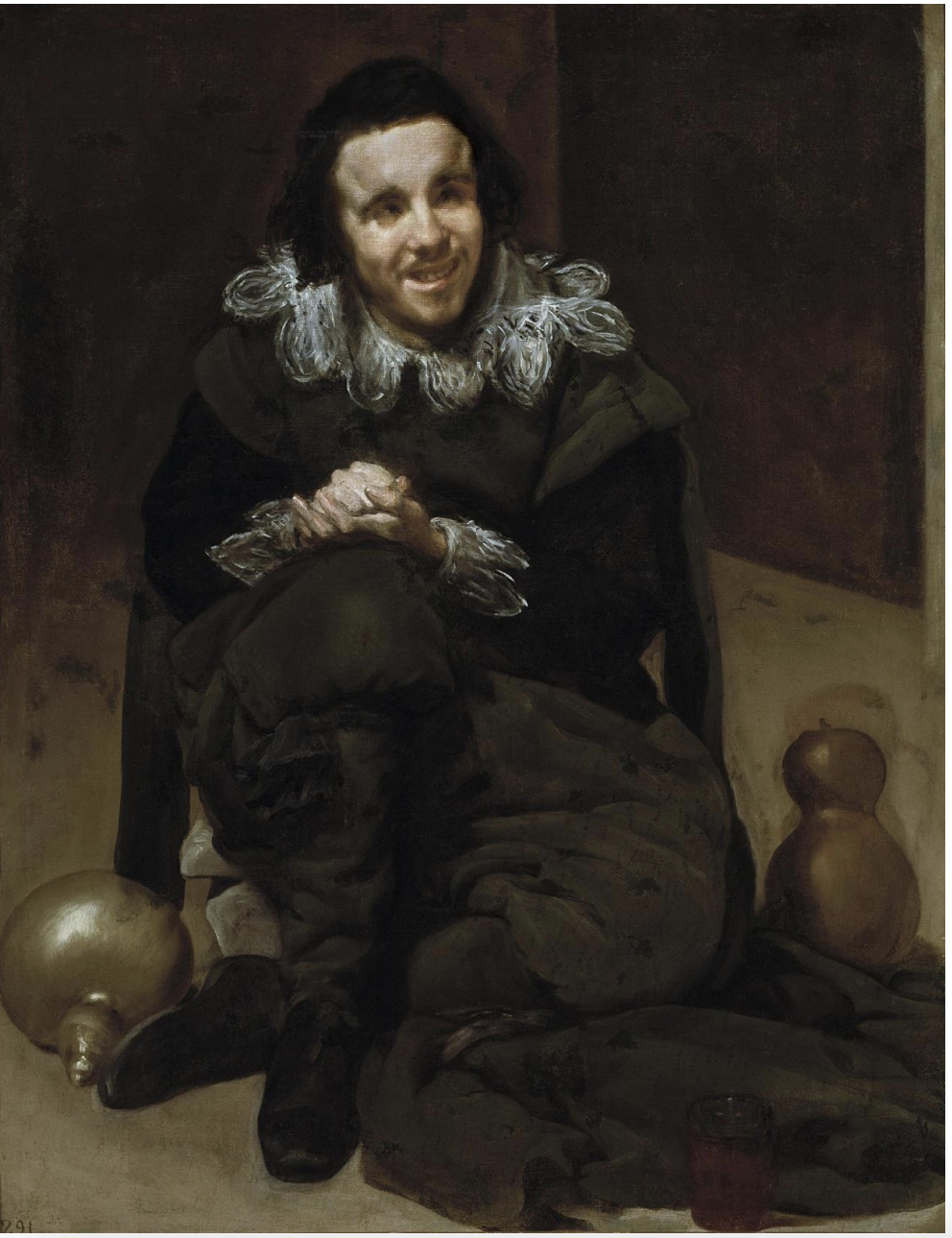
Diego Velázquez: Las Meninas (1656-57)
Talked about this one a lot
Key Features:
Depicts the royal family of Spain with Princess Margaret Theresa at the center.
Velázquez includes himself in the painting, positioning himself as both an observer and participant in the scene.
Complex use of perspective and reflection (the mirror shows the king and queen).
Memorable Fact: It's often seen as a commentary on the role of the artist and the nature of art itself.
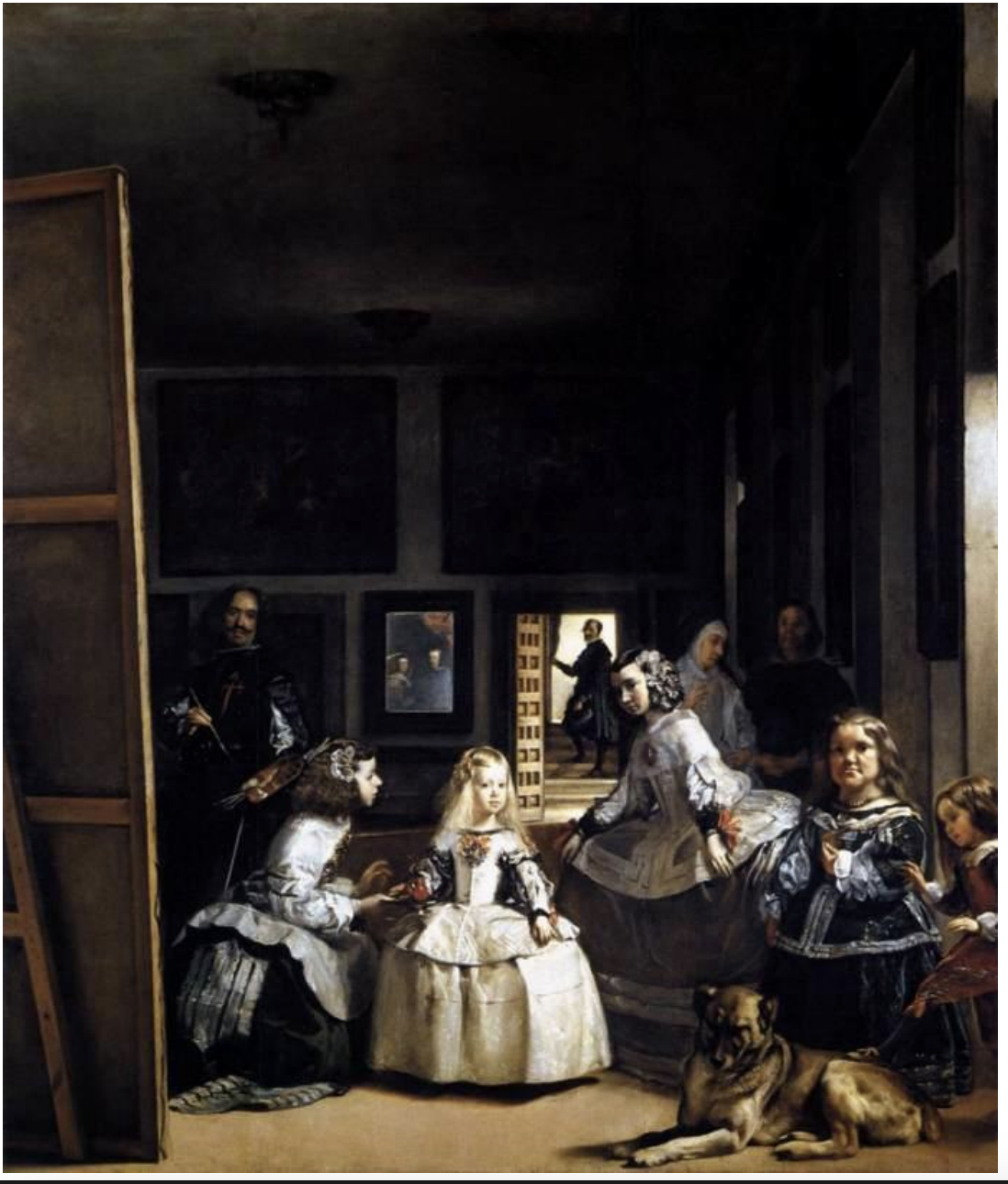
Diego Velázquez: The Fable of Arachne (Las Hilanderas) (c. 1657)
Key Features:
Depicts the myth of Arachne, a weaver transformed into a spider by the goddess Athena.
Velázquez’s use of intricate detail and textures is notable, especially in the depiction of the weaving process.
Memorable Fact: This work blends mythological storytelling with Velázquez’s exceptional skill in realism.
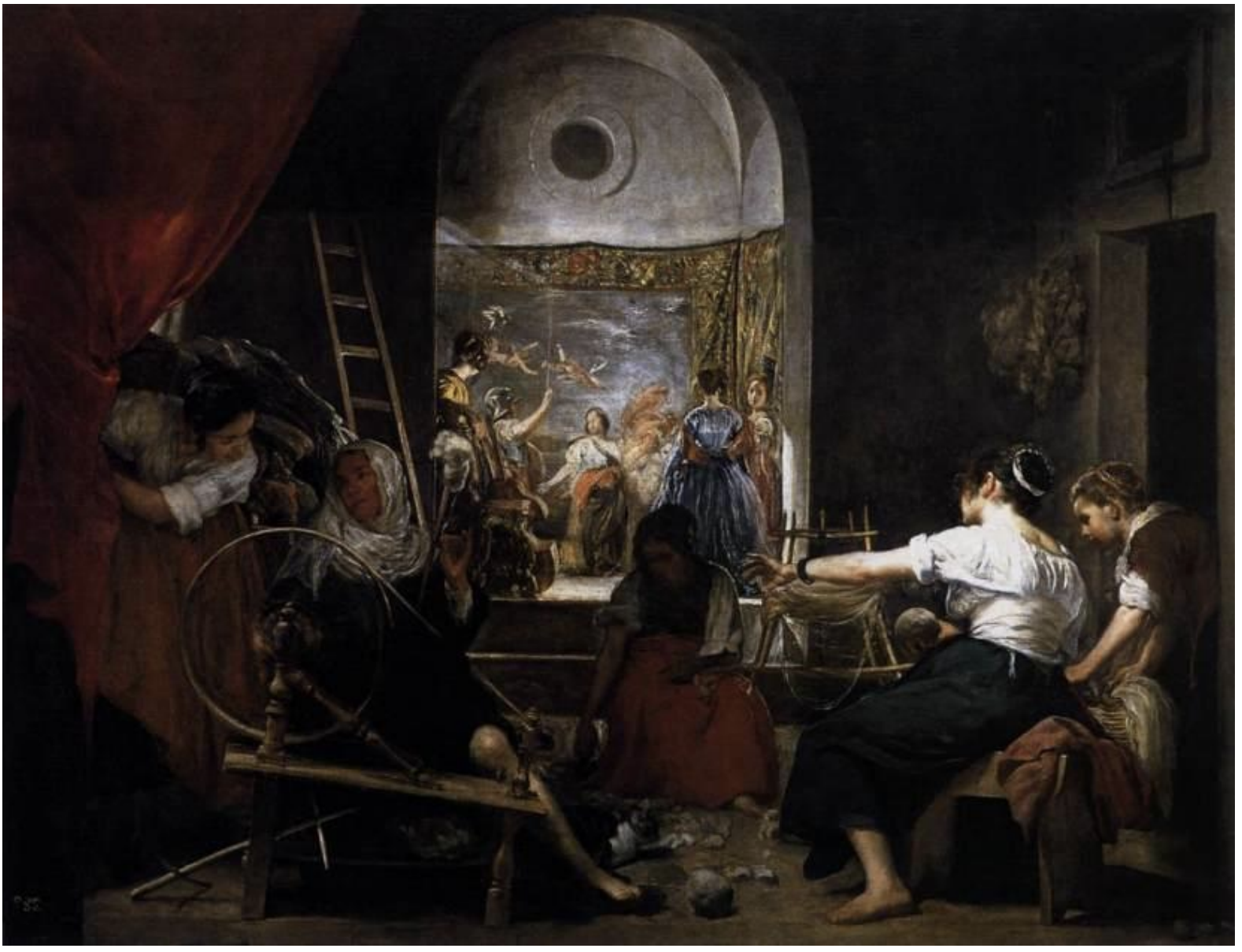
Francisco de Goya: La maja desnuda (The Nude Maja) (1798-1805)
Key Features:
A controversial painting depicting a woman in the nude, regarded for its boldness at the time.
A sensual yet detached portrayal of the female form, with no clear narrative.
Memorable Fact: This painting was highly controversial and remains one of Goya’s most famous works.
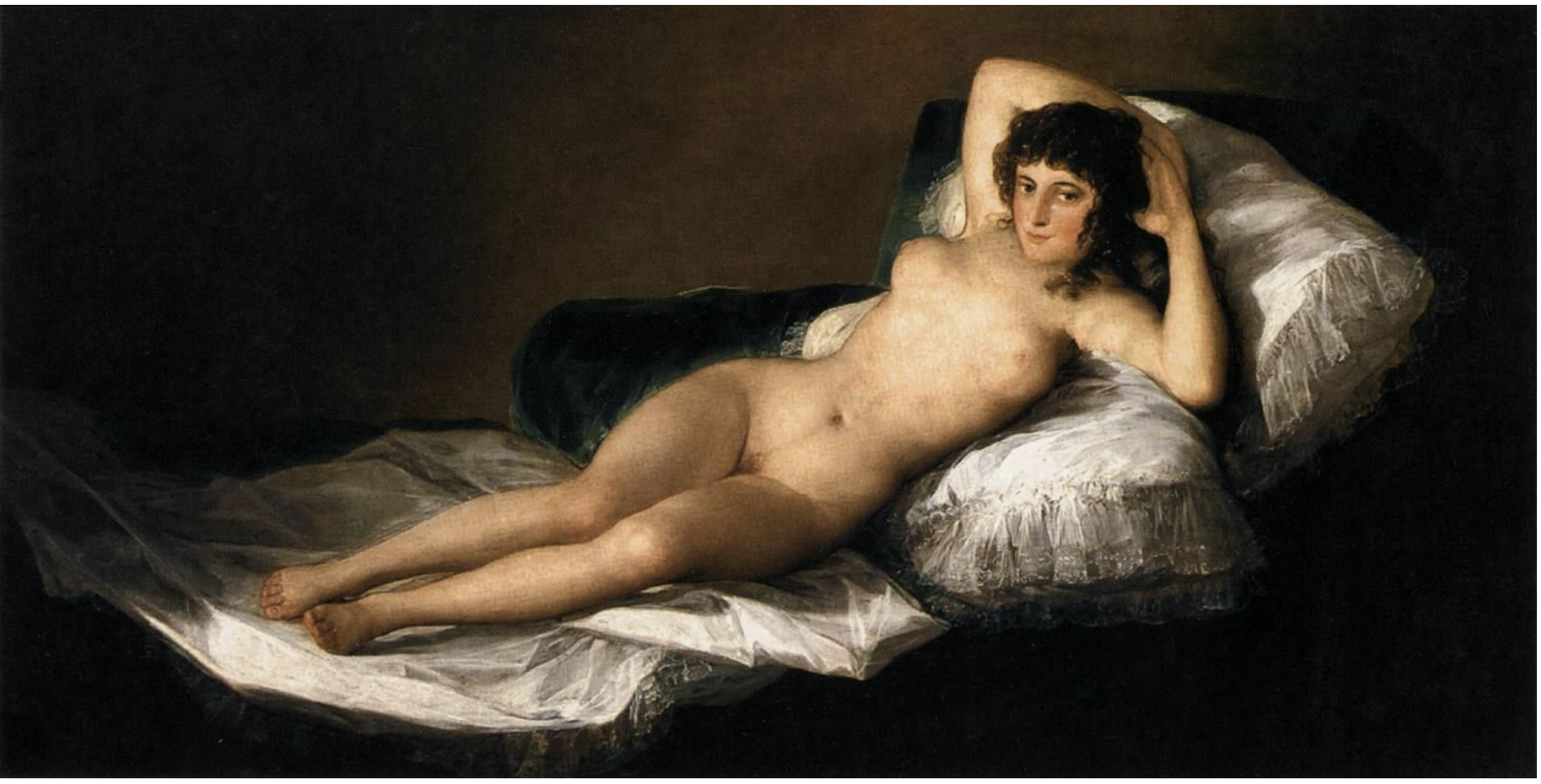
Francisco de Goya: La maja vestida (The Clothed Maja) (1798-1805)
Key Features:
The clothed version of the same woman from The Nude Maja.
It is said to be a companion piece, meant to balance the sensuality of the nude with the formality of a dressed figure.
Memorable Fact: Goya’s fascination with the female figure and societal mores is evident in both works.
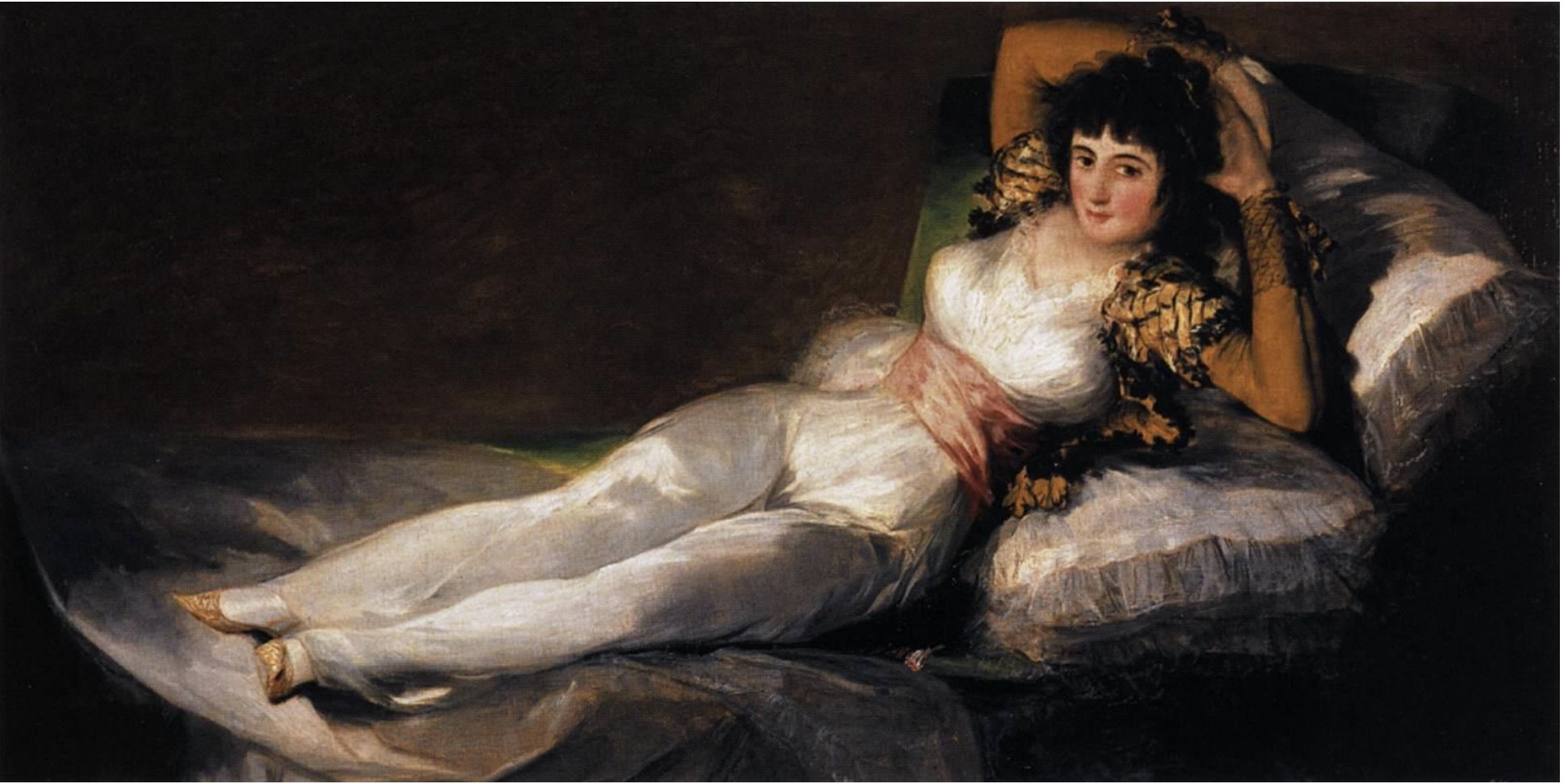
Francisco de Goya: La familia de Carlos IV (Charles IV and his Family) (1800-01)
Key Features:
A royal portrait of the Spanish royal family, often interpreted as a critique of the monarchy’s pomp and arrogance.
Goya’s skill in capturing the personalities and flaws of his subjects is central to this work.
Memorable Fact: Goya’s honest portrayal of the royal family contrasts with the idealized royal portraits of the time.
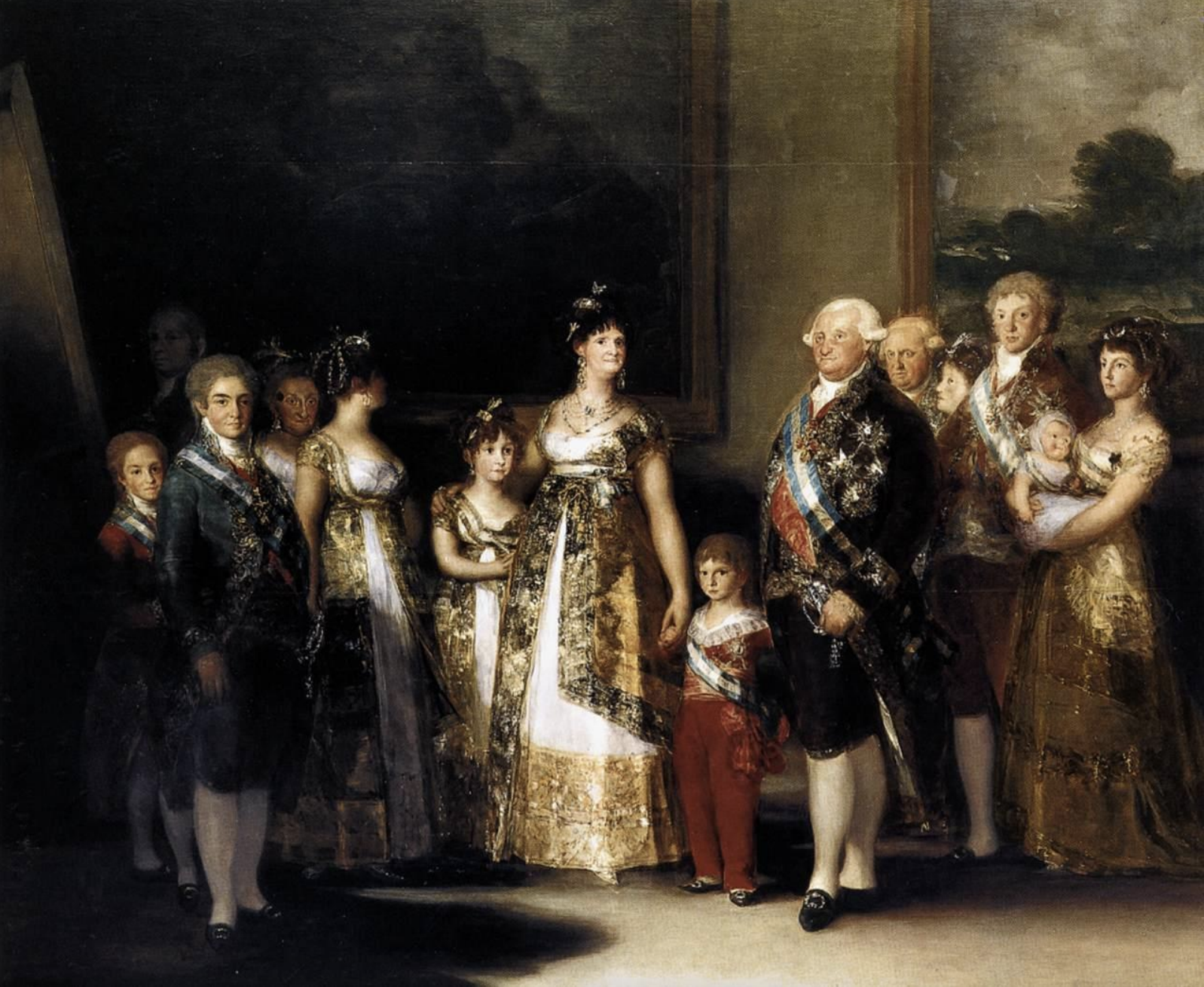
Francisco de Goya: El Dos de Mayo de 1808 (The Second of May 1808) (1814)
Focus on this one since we talked about it a lot in class
Key Features:
Depicts the brutal repression of Spanish civilians during the French occupation of Spain.
Strong emotional intensity and focus on the chaos of the event.
Memorable Fact: It’s a dramatic, political painting meant to evoke sympathy for the Spanish resistance.
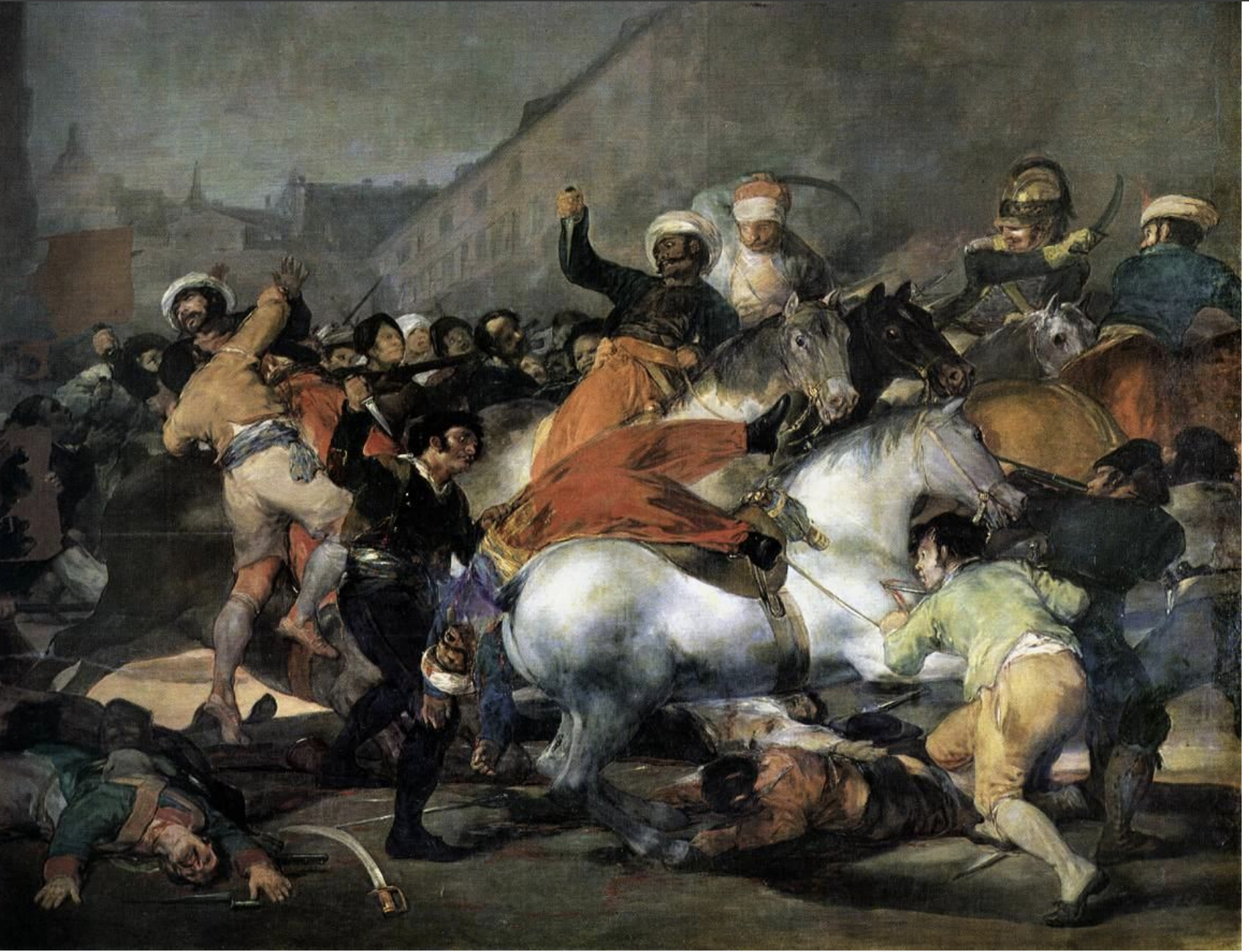
Francisco de Goya: El Tres de Mayo de 1808 (The Third of May 1808) (1814)
Key Features:
A stark portrayal of the execution of Spanish civilians by French soldiers.
Use of light and shadow highlights the innocence and helplessness of the victims.
Memorable Fact: Goya’s stark realism in this piece makes it a profound anti-war statement.
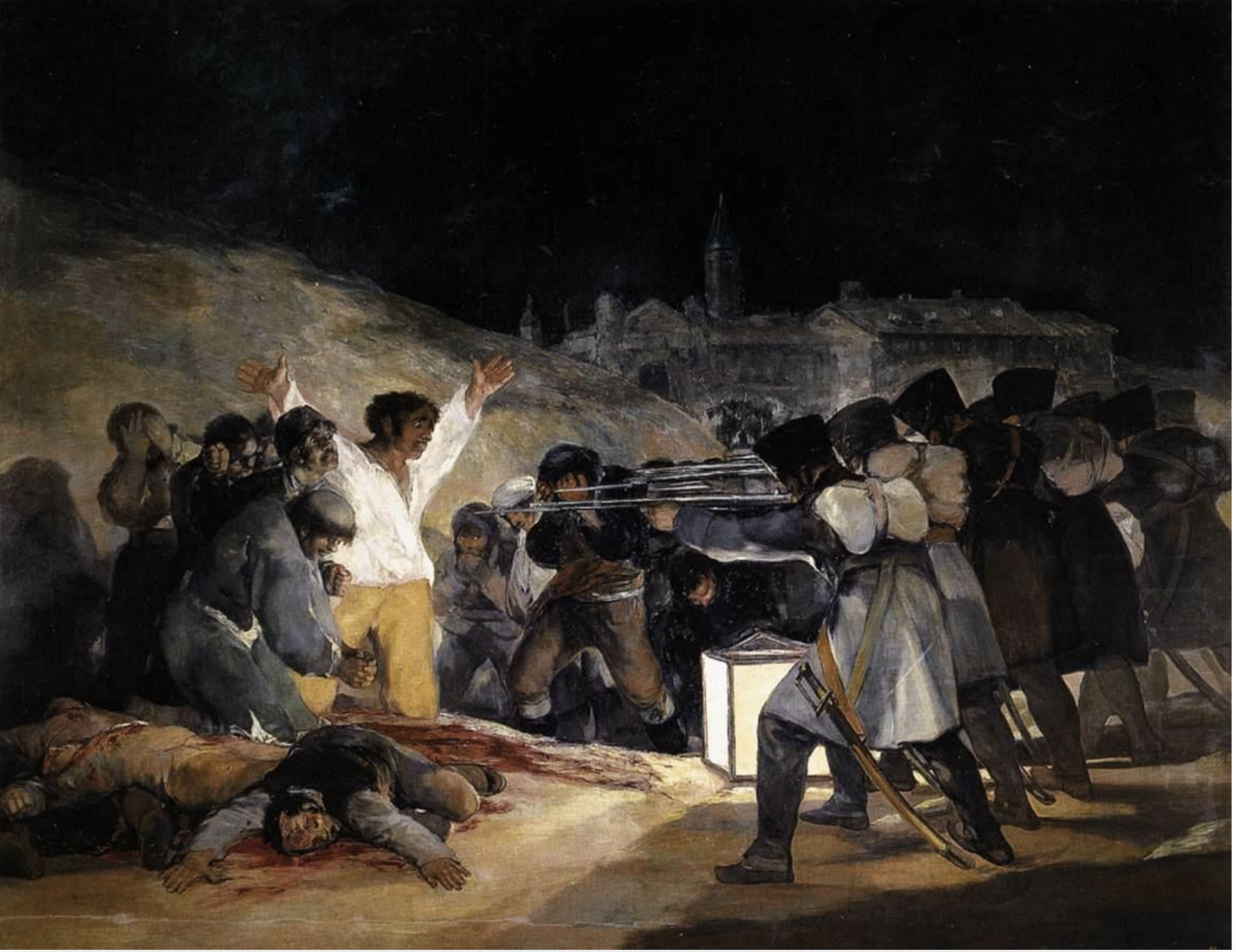
Francisco de Goya: Aquelarre o El Gran Cabrón (Witches' Sabbath or The Great He-Goat) (1820-23)
Key Features:
Depicts a scene of witches in a nightmarish gathering around a demonic figure, often interpreted as the "Great He-Goat" or Satan.
Goya uses dark, ominous colors and unsettling imagery to create a sense of dread and chaos.
The subject matter likely references the superstition and fear surrounding witchcraft during Goya’s time.
Memorable Fact: It is part of Goya’s "Black Paintings" series, which reflects his personal disillusionment and the darkness of his later years.
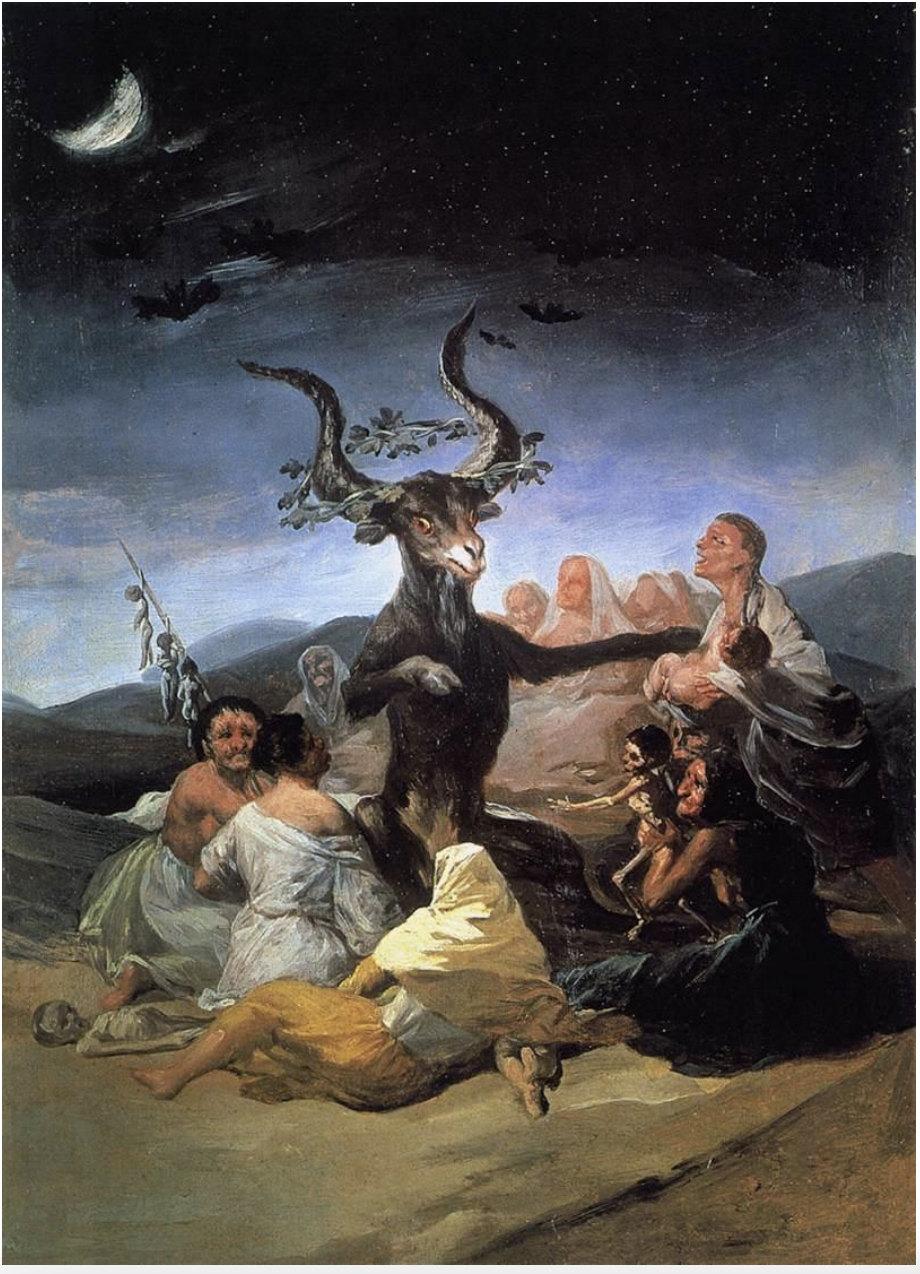
Francisco de Goya: Saturno devorando a sus hijos (Saturn Devouring His Son) (1819-23)
Key Features:
Depicts the Roman god Saturn eating one of his own children, a horrifying scene inspired by myth.
The painting features raw emotion, with Saturn portrayed as a monstrous figure consumed by madness and hunger.
Goya’s use of dark, muted colors and disturbing imagery makes this one of his most disturbing works.
Memorable Fact: This piece is another from Goya’s "Black Paintings," showcasing his deep despair and critique of human nature.
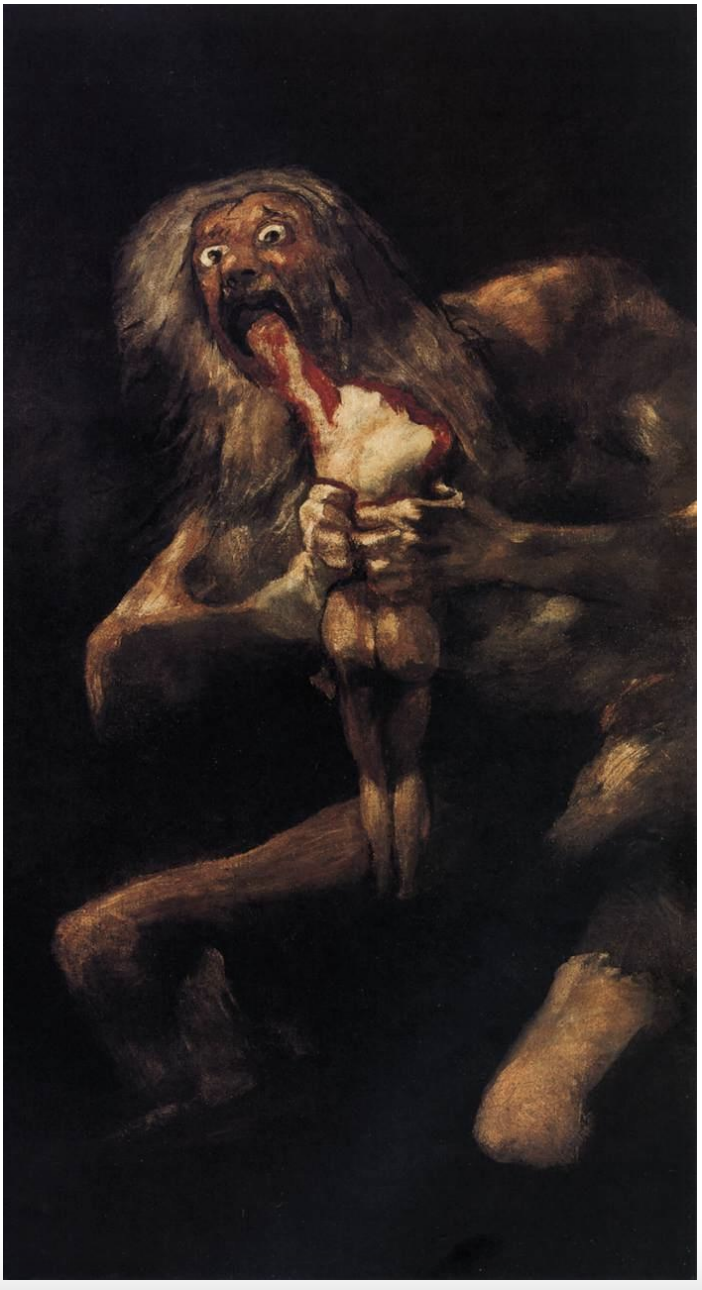
Joaquín Sorolla: Triste herencia (Sad Inheritance) (1896)
Key Features:
Depicts a scene at the beach where disabled children are being cared for by a caretaker, symbolizing both innocence and sadness.
Sorolla’s use of light and color captures the melancholy tone of the scene while highlighting the beauty of the coastal setting.
The painting emphasizes social issues, reflecting the plight of marginalized individuals.
Memorable Fact: This work is known for Sorolla’s compassionate depiction of social themes, as well as his mastery of light and water.
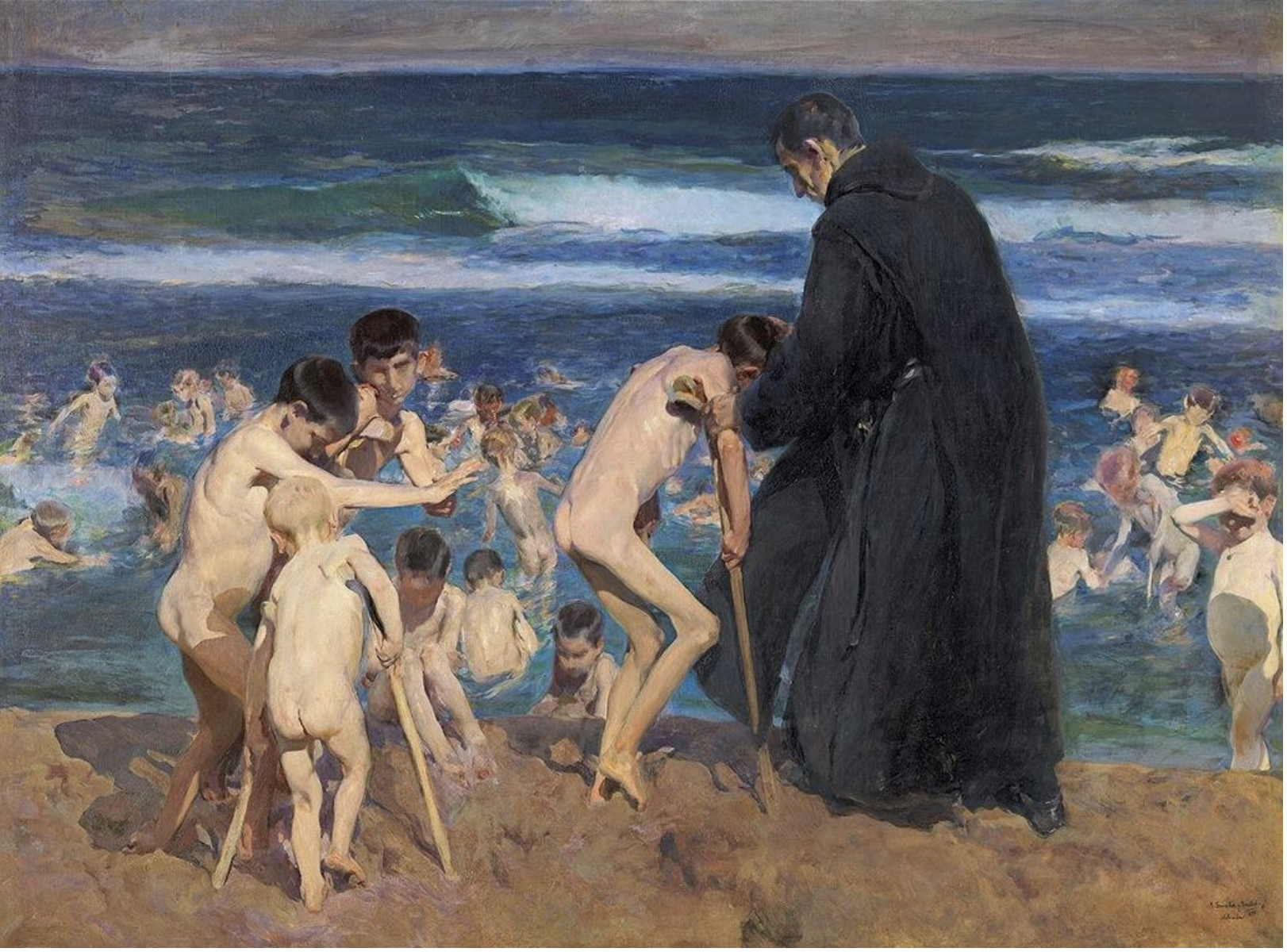
Joaquín Sorolla: Paseo por la playa (Walk on the Beach) (1909)
Style: Impressionism
Key Features:
Depicts a joyful scene of people walking along the beach, capturing the lively atmosphere and sunlight.
Sorolla’s famous technique of using bright, vivid colors is apparent here, with natural light reflecting on the figures and water.
The figures are depicted in motion, emphasizing Sorolla’s skill in portraying the human form in a fluid and natural way.
Memorable Fact: The painting showcases Sorolla’s love of nature and his ability to capture light and movement.
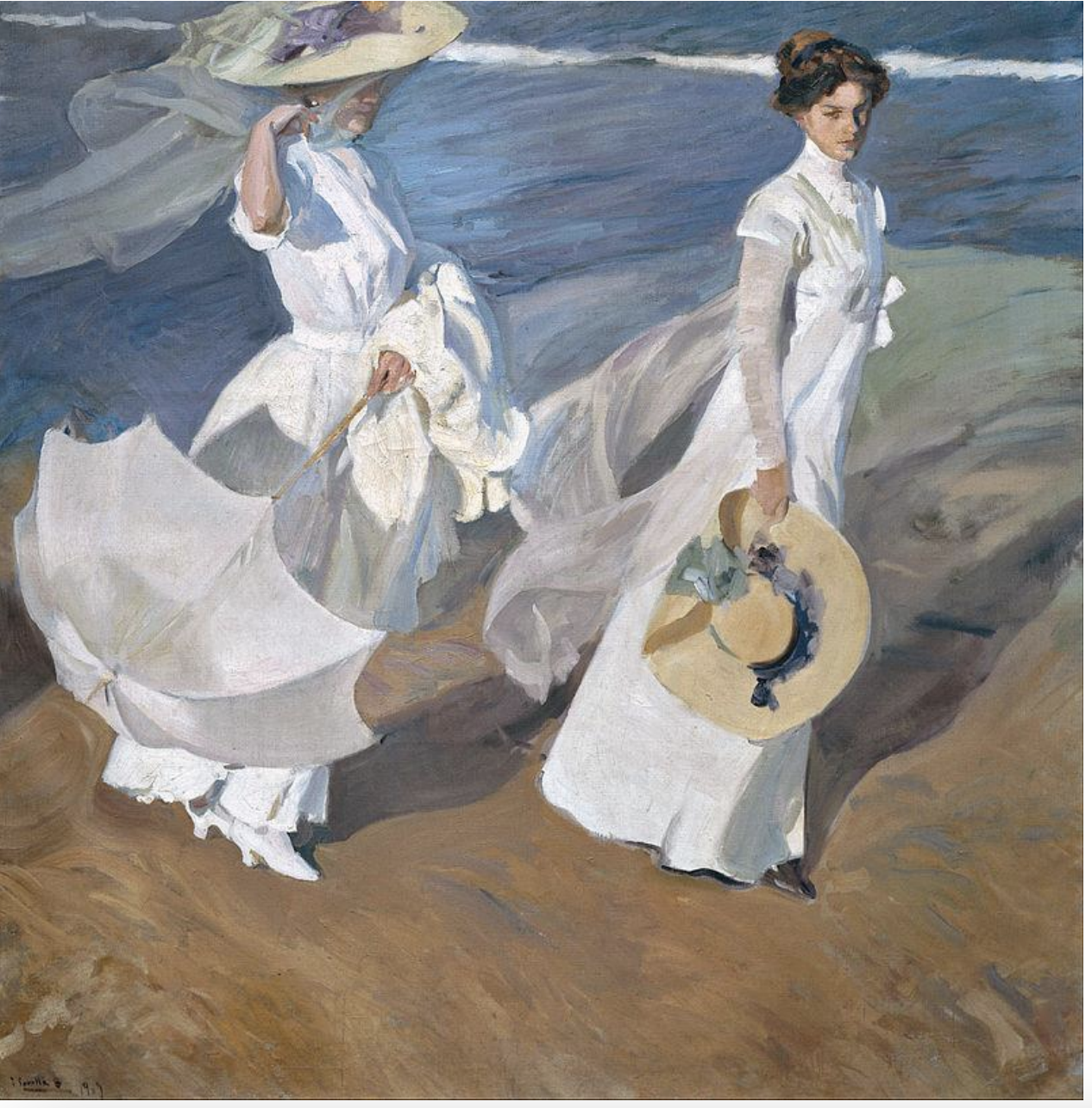
Joaquín Sorolla: Niños en la playa (Boys on the Beach) (1910)
Key Features:
Sorolla’s portrayal of children playing on the beach is full of light, color, and movement.
The focus is on the carefree nature of childhood, with vibrant blues and greens reflecting the coastal environment.
The depiction of the children’s figures is relaxed and joyful, showcasing Sorolla’s ability to capture moments of innocence.
Memorable Fact: One of Sorolla’s most famous beach scenes, celebrated for its joyful energy and beautiful use of sunlight.
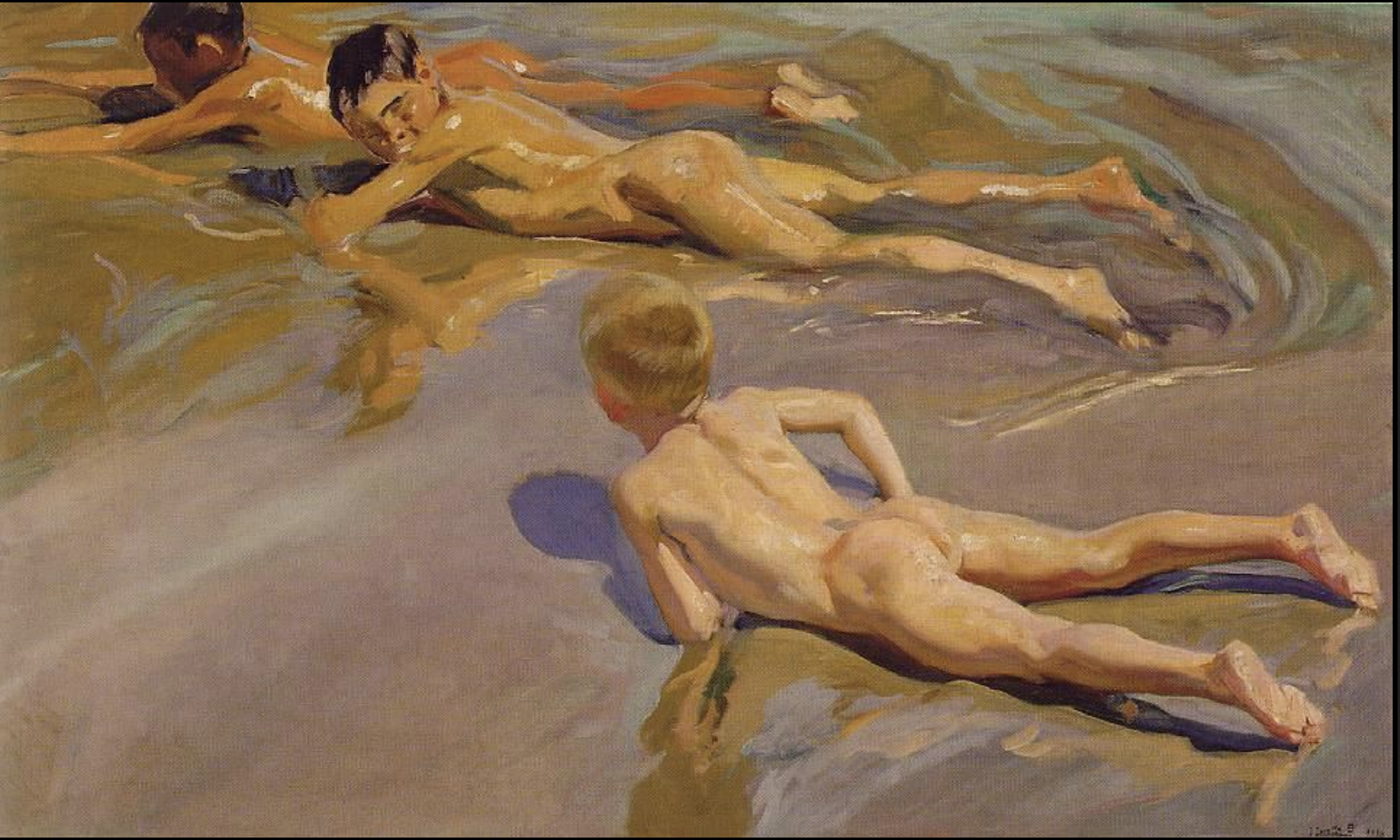
Pablo Picasso: Family of Saltimbanques (1905)
Key Features:
Depicts a group of circus performers (saltimbanques) in a melancholic, isolated setting.
The use of warm, earthy tones and the somewhat somber expressions of the figures reflect the emotional vulnerability of the performers.
The painting shows Picasso’s transition from his Blue Period into his Rose Period, focusing on themes of loneliness and hardship.
Memorable Fact: This work is considered an introspective exploration of the human condition during Picasso’s emotional transition.

. Pablo Picasso: Les Demoiselles d'Avignon (1907)
Key Features:
Depicts five nude women in a brothel, with fragmented and angular forms that challenge traditional notions of the human figure.
The painting is known for its break with perspective, using geometric shapes and sharp angles to distort the human body.
It marks the birth of Cubism, a revolutionary style that Picasso co-developed with Georges Braque.
Memorable Fact: Considered one of Picasso’s most important works, it shattered artistic conventions and paved the way for the development of Cubism.
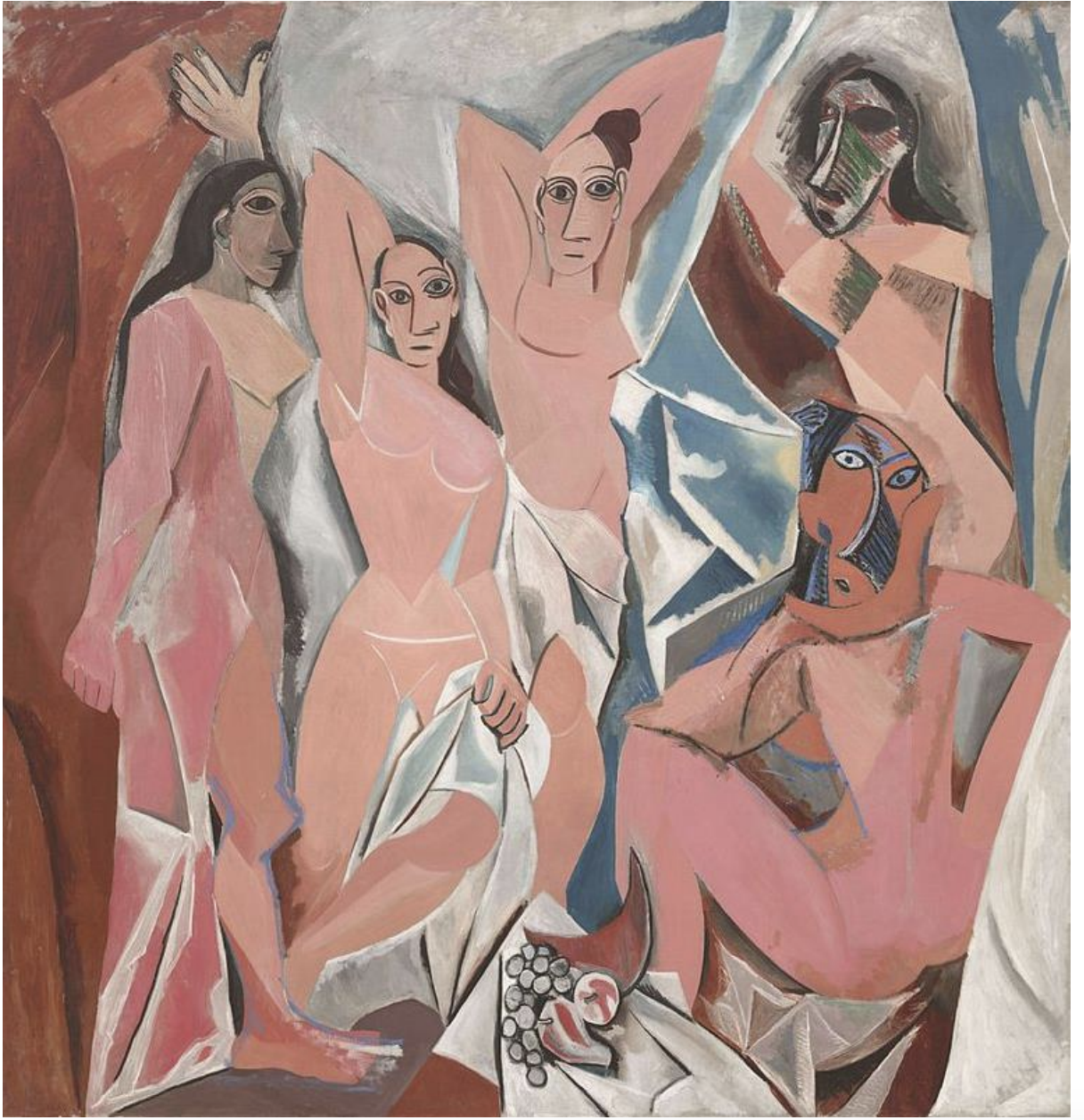
Pablo Picasso: Still-Life with Chair Caning (1912)
Key Features:
A mixed-media work that incorporates elements of collage, blending painted forms with actual materials like chair caning.
The composition plays with the perception of space and objects, breaking them down into simplified shapes and textures.
It challenges the viewer’s understanding of reality by juxtaposing familiar and abstract elements.
Memorable Fact: One of the earliest examples of collage in modern art, symbolizing Picasso’s experimentation with Cubism.
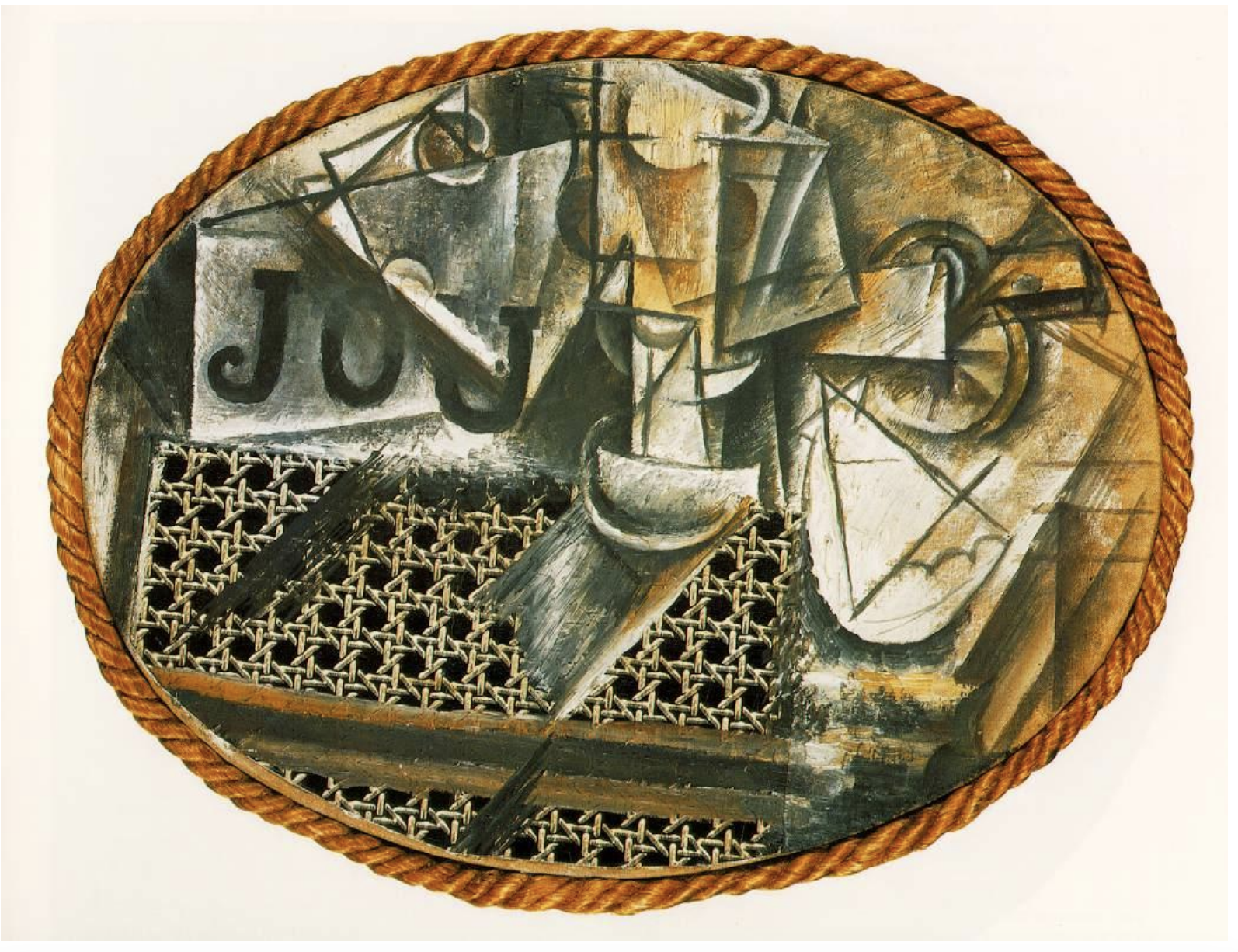
Pablo Picasso: Glass and Bottle of Suze (1912)
Key Features:
A still life of a glass and bottle of Suze, a French aperitif, depicted through fragmented, geometric forms.
The piece emphasizes Picasso’s ongoing exploration of Cubism and the deconstruction of everyday objects.
The focus on texture and form creates a new way of seeing ordinary items.
Memorable Fact: This painting exemplifies Picasso’s innovation in Cubism, turning a simple subject into a complex visual puzzle.
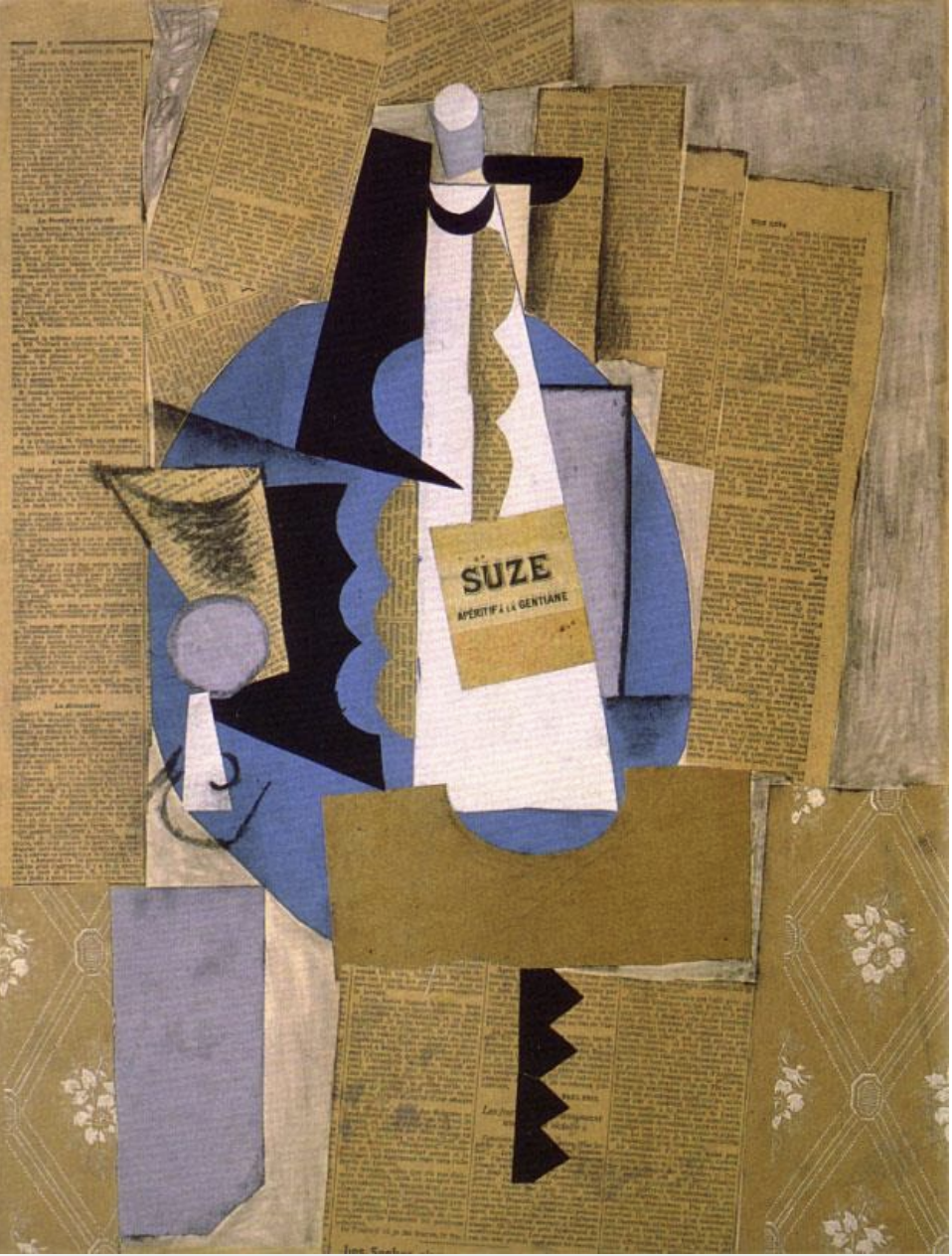
Pablo Picasso: Guernica (1937)
Key Features:
A powerful anti-war mural depicting the bombing of the Spanish town of Guernica during the Spanish Civil War.
The chaotic, distorted forms of humans and animals represent the horror and suffering caused by the bombing.
Picasso uses a monochromatic palette of blacks, whites, and grays to evoke a somber and grim tone.
Memorable Fact: Guernica is one of the most iconic anti-war artworks in history, symbolizing the brutality of war and the impact on civilians.
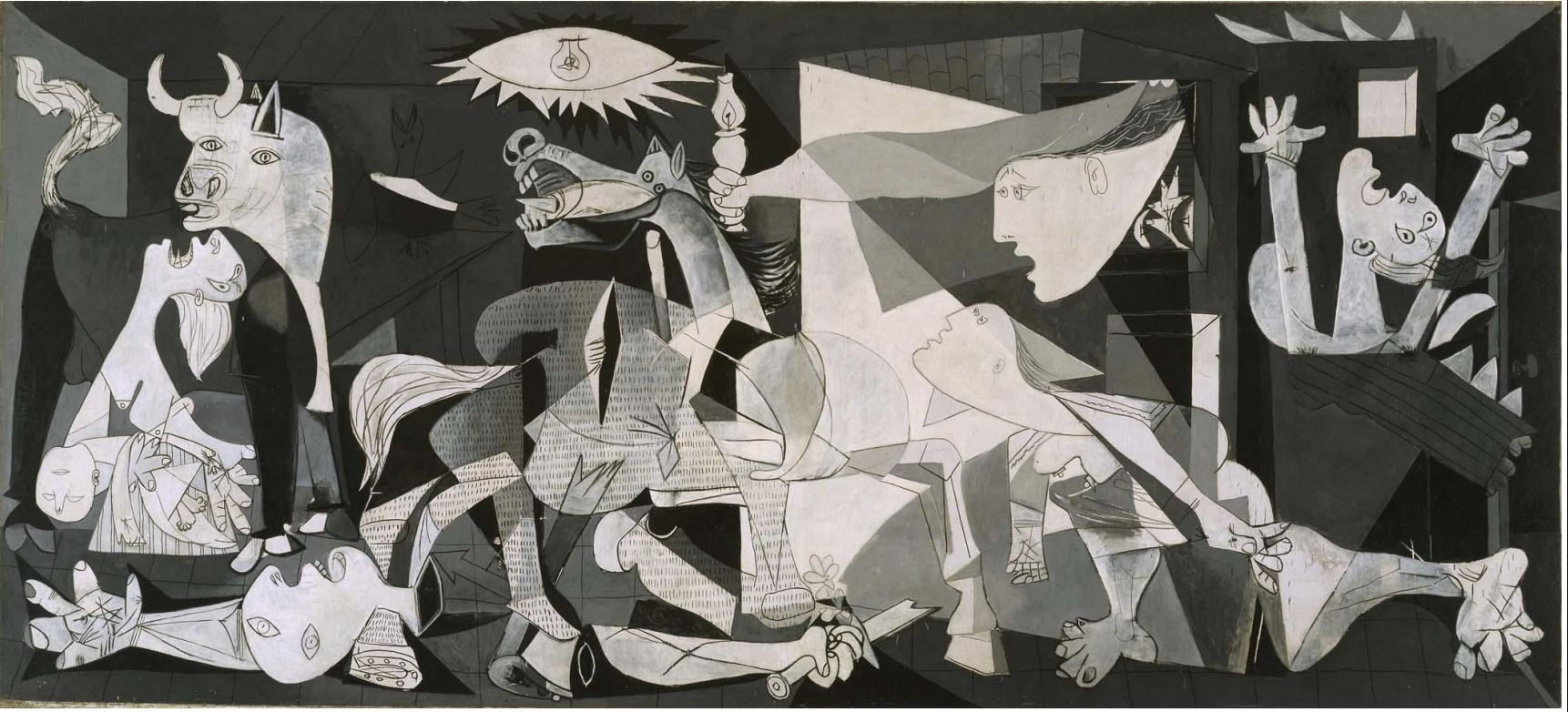
Juan Gris: Still Life with Checkered Tablecloth (1915)
Key Features:
A still life composed of fragmented, angular objects arranged in a complex, layered composition.
Gris employs the techniques of Cubism to break down the objects into geometric shapes and rearrange them in abstract forms.
The checkered tablecloth introduces a pattern that contrasts with the more angular, disjointed elements.
Memorable Fact: Gris was a leading figure in Synthetic Cubism, which used more recognizable shapes and forms compared to earlier, more abstract Cubism.
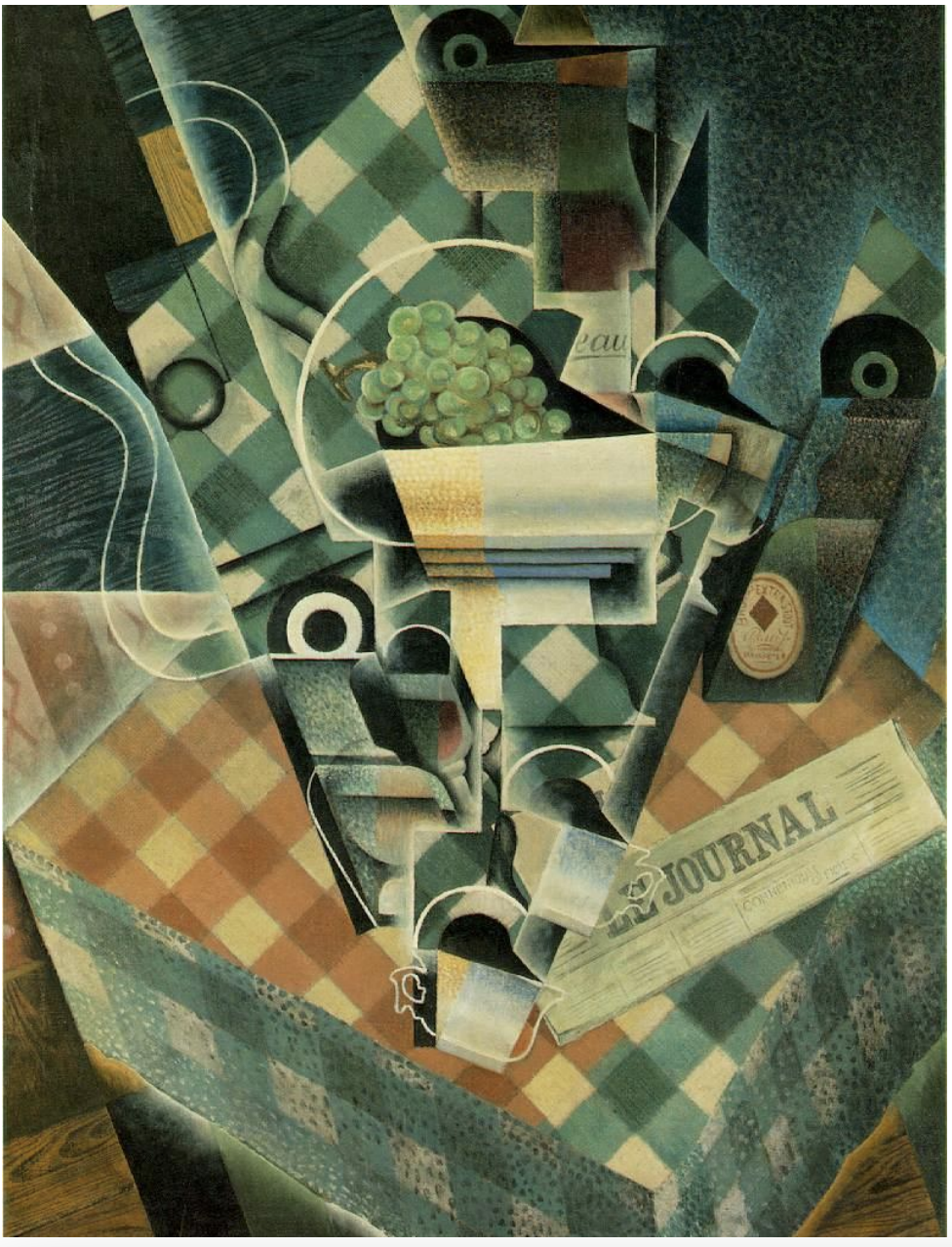
Joan Miró: Catalan Landscape (The Hunter) (1923-24)
Key Features:
A surreal landscape with abstract, organic shapes and symbols representing the Catalan countryside.
The painting evokes the primal energy of nature through simple, bold colors and forms.
Miró’s use of minimalistic yet dynamic shapes conveys a sense of motion and life.
Memorable Fact: The use of symbolic shapes represents Miró’s unique vision of nature and the unconscious mind.
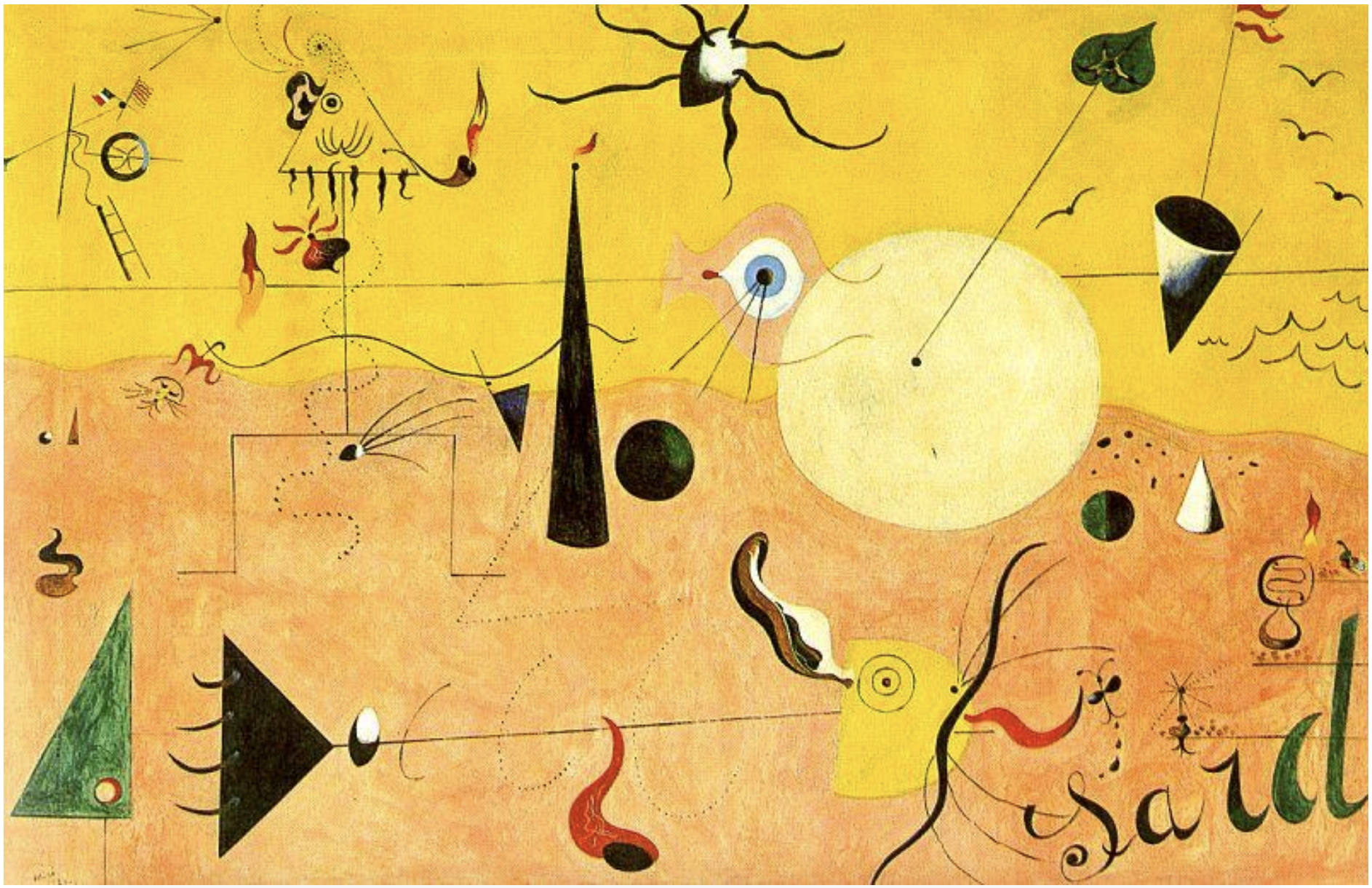
Joan Miró: Figures and Dog in front of the Sun (1949)
Key Features:
Features simplified, playful forms of figures and a dog against a bright sun.
Miró’s signature style includes bold, vibrant colors and the use of surrealistic, dreamlike imagery.
The piece suggests a connection to the subconscious and the human relationship with the universe.
Memorable Fact: This work demonstrates Miró’s evolving style, moving deeper into abstract forms with personal symbolism.
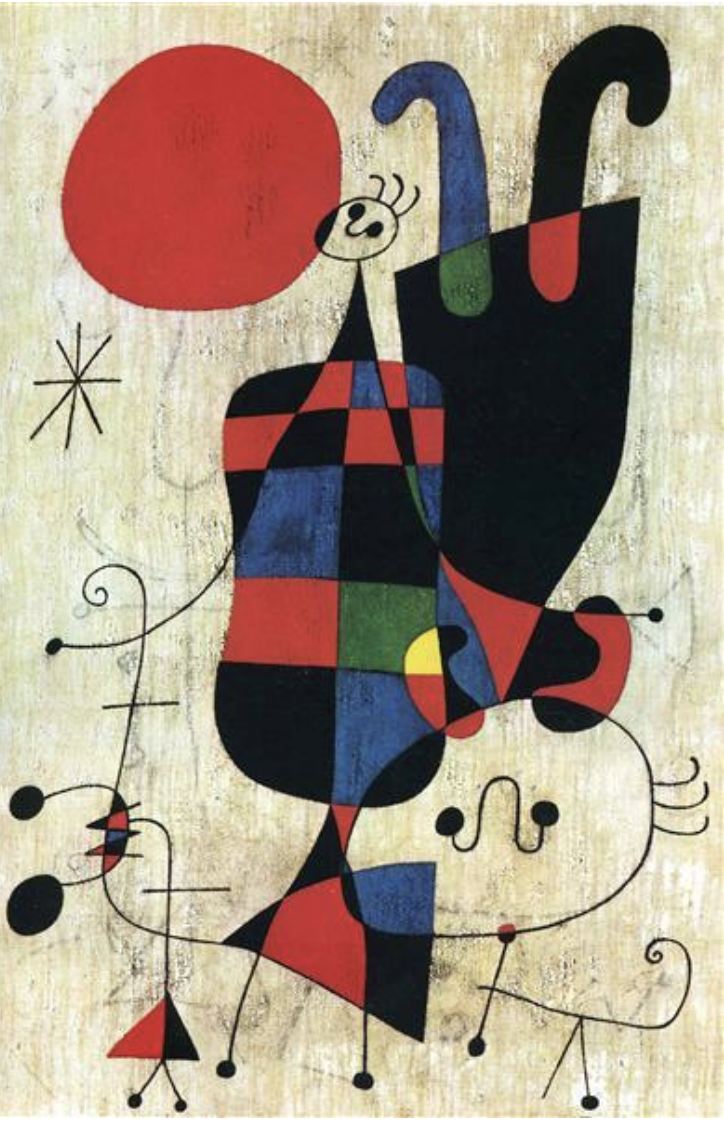
Salvador Dalí: The Great Masturbator (1929)
Key Features:
A highly symbolic and bizarre self-portrait that combines elements of sexuality, paranoia, and the unconscious mind.
Dalí’s signature melting forms and distorted imagery reflect the irrational nature of human desire.
The painting features a distorted face and a phallic figure, representing both eroticism and fear.
Memorable Fact: Dalí’s exploration of the subconscious mind and the erotic, as well as his technical mastery, make this one of his iconic works.
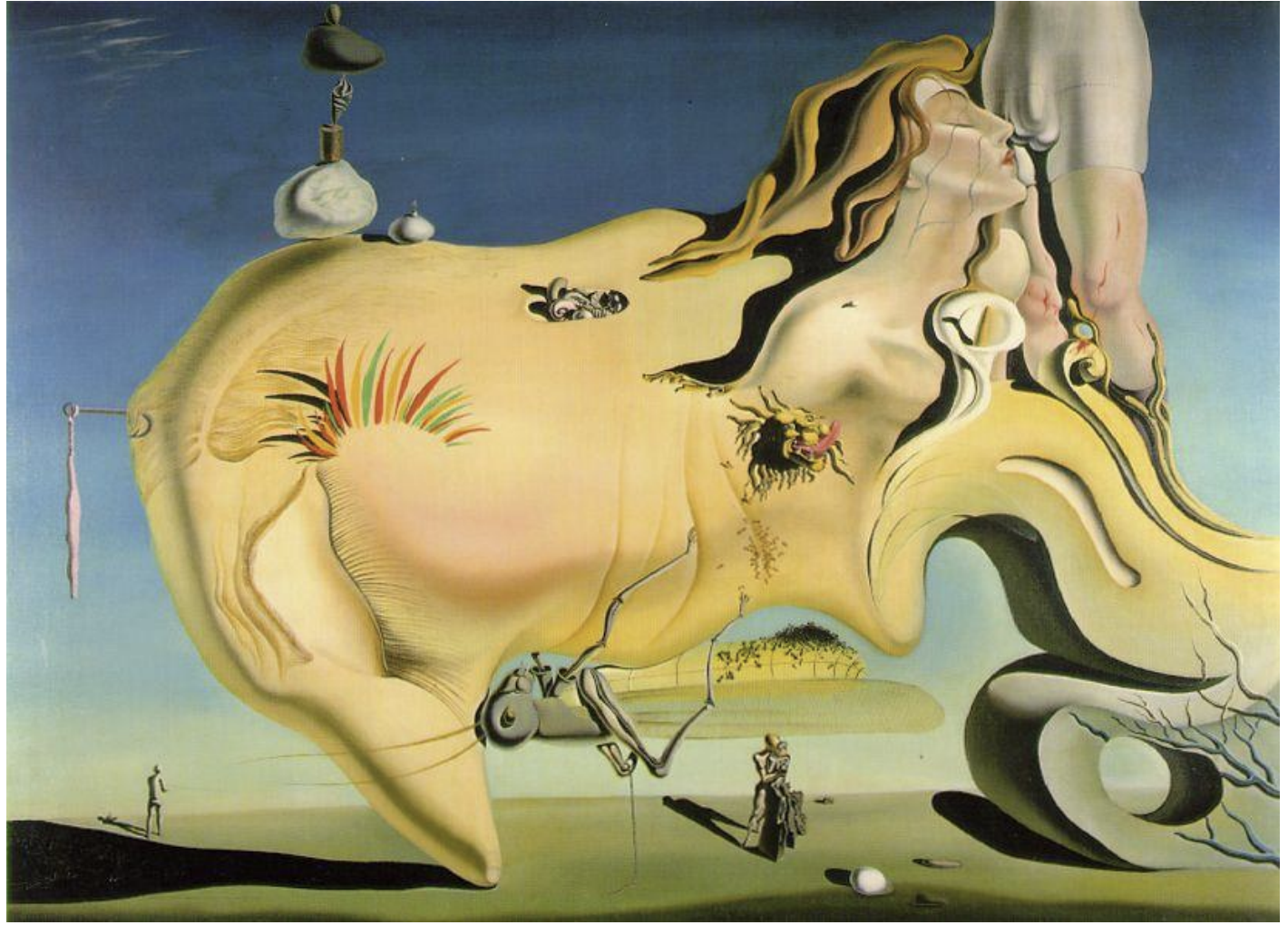
Salvador Dalí: The Persistence of Memory (1931)
Key Features:
Famous for its melting clocks draped over objects in a desolate landscape, representing the fluidity and distortion of time.
The scene conveys a sense of dreamlike unreality, where time seems to collapse and lose its meaning.
Dalí uses highly realistic techniques to depict the bizarre, further emphasizing the surreal nature of the work.
Memorable Fact: This painting is one of Dalí’s most iconic, symbolizing the relativity of time and reality.
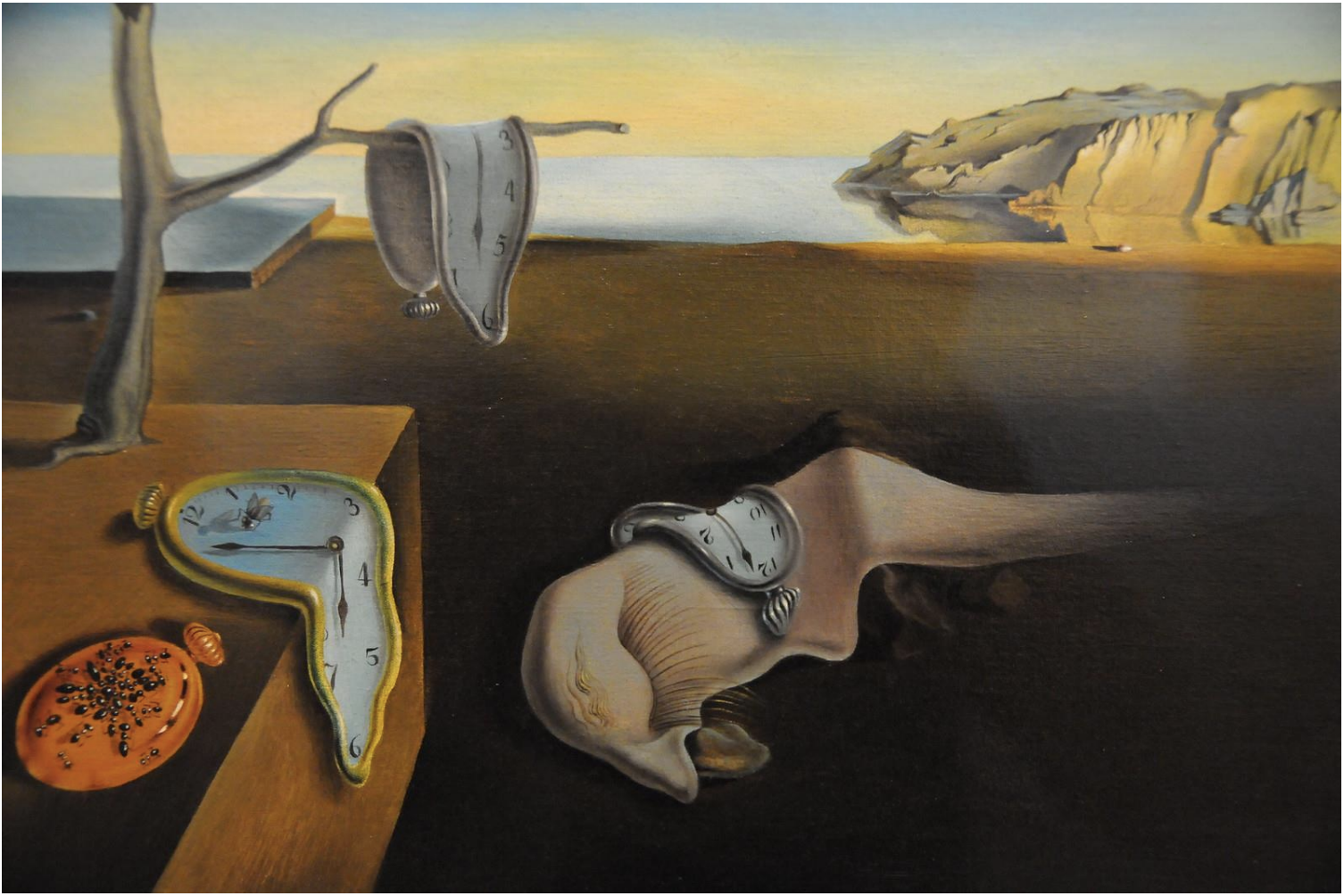
Salvador Dalí: Atavistic Ruins after the Rain (1934)
Key Features:
The painting features decayed, almost prehistoric ruins, suggesting a connection to ancient history and the passage of time.
Dalí’s exploration of landscape and architecture in a dreamlike, distorted manner reflects his fascination with decay and memory.
Memorable Fact: This painting combines Dalí’s love for surreal landscapes with his deep thoughts on time and history.
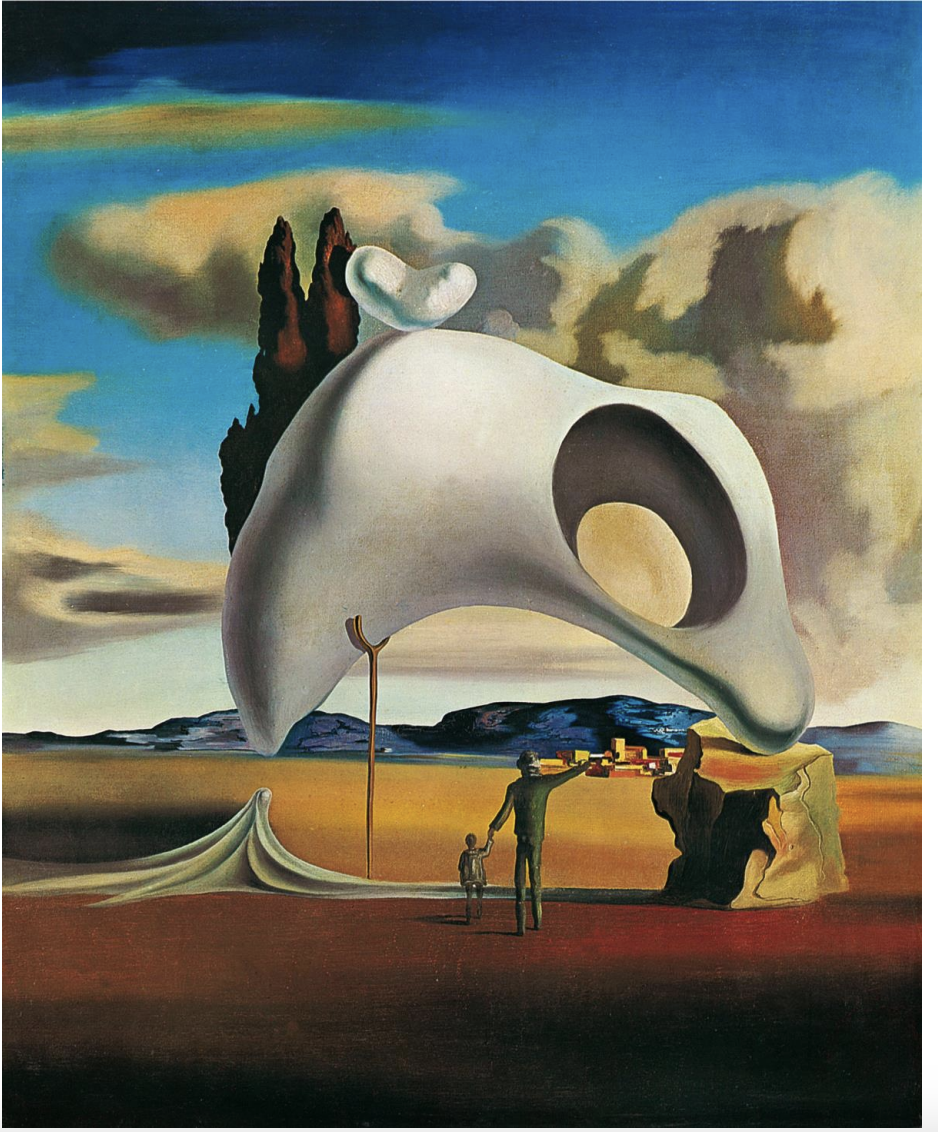
Salvador Dalí: Soft Construction with Boiled Beans (Premonition of Civil War) (1936)
Key Features:
Depicts a grotesque, disintegrating human figure in an agonizing pose, representing the chaos and violence of the Spanish Civil War.
The image of soft, melting flesh contrasts with the harsh, chaotic background, symbolizing the horror of conflict.
Dalí uses his signature distorted forms to evoke a sense of terror and disarray.
Memorable Fact: A politically charged work, it reflects Dalí’s reaction to the Spanish Civil War and the impending destruction it foretells.
